Nectar 3 Help
Introduction

Get your vocals to sit in the mix with the most sophisticated set of tools designed for vocal production. First introduced in 2010, Nectar has made a space in studios all over the world, offering world-class processing designed to get to a professional result in seconds. With version 3, Nectar helps your vocal tracks sing by addressing each part of the vocal production chain, offering invaluable assistive features, and communication across your session. From corrective to creative vocal production all the way to the final polish, Nectar 3 brings forth your intended performance in isolation and in the context of the mix. Put your vocals in their place with everything they need for a clear, professional sound.
QUICKLY BUILD VOCAL PROCESSING CHAINS & UNMASK YOUR VOCAL
Vocal Assistant: Give your vocal the attention it deserves with Vocal Assistant.
- Assist: One-click custom preset creation created with machine learning technology to help your vocal fit in the mix in seconds.
- Unmask: Puts your vocal at the forefront of your mix by carving away other competing mix elements directly from Vocal Assistant’s menu screen.
CATCH EVERY BREATH
Nectar 3 is bundled with iZotope RX 8 Breath Control, which is designed to intelligently detect breaths in dialogue or vocal recordings and automatically suppress them, saving invaluable time in the comping and prep stage of vocal editing.
A MATCH MADE IN HEAVEN: Celemony Melodyne 4 essential
As an added benefit to Nectar 3’s built-in Pitch correction module, iZotope has partnered with Celemony to include Melodyne 4 essential: GRAMMY-award winning pitch and time correction. Melodyne adds surgical, intuitive, and truly transparent pitch adjustment capabilities that are an industry standard in professional studios around the world.
IMPROVED, REVAMPED MODULES AND REFRESHED USER INTERFACE
- EQ: Shape the tone and character of your vocal with two completely redesigned EQ
modules.
- Add up to 24 bands per EQ module, with 16 different filter shape options per band.
- Dynamic EQ processing modes:
- Dynamic Frequency: Dynamically update a filters Frequency to track vocal harmonics as they change throughout a performance.
- Dynamic Gain: Dynamically trigger EQ boosts and cuts based on the incoming vocal level.
- Delay: Independent stereo delay controls and two brand new saturation modes.
- De-esser: Refined interface and interactive Threshold control.
- Saturation: Two new Saturation modes, Decimate and Distort.
- Harmony: Add up to eight synthetic harmony voices. Improved MIDI mode playability.
- Compressor: Refined interface and interactive controls.
- Reverb: Increased control the post filter and enhanced user interface.
- Dimension: Modulate your vocal with the Chorus, Flanger and Phaser modes in the brand new Dimension module.
- Gate: New Close Threshold feature for controlling hysteresis.
Vocal Assistant
Overview
Vocal Assistant will intelligently create an optimal starting point for a vocal. It can also help a vocal stand out in the mix by communicating with IPC compatible iZotope plug-ins to unmask the vocal from other elements in the mix.
Click the “Vocal Assistant” button in the header of the plug-in interface to open the Vocal Assistant screen.

Assist and Unmask
Vocal Assistant offers two different paths: Assist and Unmask.

Assist and Unmask processing options can be selected simultaneously.
Unmask Requires an IPC source to work
Unmask requires a compatible iZotope plug-in to be inserted on another track in your session in order to work. Unmask analysis can occur when one of the following plug-ins is present as an insert on the track that is masking your vocal: Relay, Nectar, or Neutron.
After making a selection, click the next button.

Processing Options
The following sections assume both options were selected in the first screen.

Assist Options
You can inform the results of Vocal Assistant processing by changing the Vibes and Intensity settings.
Vibes
Informs the initial EQ and Dynamics settings applied to the vocal.

Intensity
Determines the amount of processing applied to the vocal.

Unmask Options
Selects the source IPC plug-in for Unmask analysis.
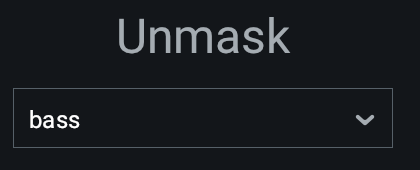
Tip: Choosing an Unmask Source
- Select a plug-in in the Unmask dropdown that is inserted on a track that is masking the vocal.
- For the best results, the source plug-in that is selected in the Unmask dropdown should be after all other
inserts on the track it is inserted on.
- For example, Insert Relay in the last insert slot of a track that is masking the vocal. Select that Relay instance from the Unmask dropdown menu.
Analysis
After configuring the Assist and Unmask Options, ensure audio is playing back and click the “Next” button to continue to the analysis screen.
Note
- Vocal Assistant needs audio input: Make sure you are playing audio in your DAW.
- Vocal Assistant needs time to analyze your vocal. If you are trying to run Vocal Assistant on a clip shorter than 20 seconds, you should enable loop playback before starting Vocal Assistant.
Assist Analysis
The Assist analysis pass will run first.
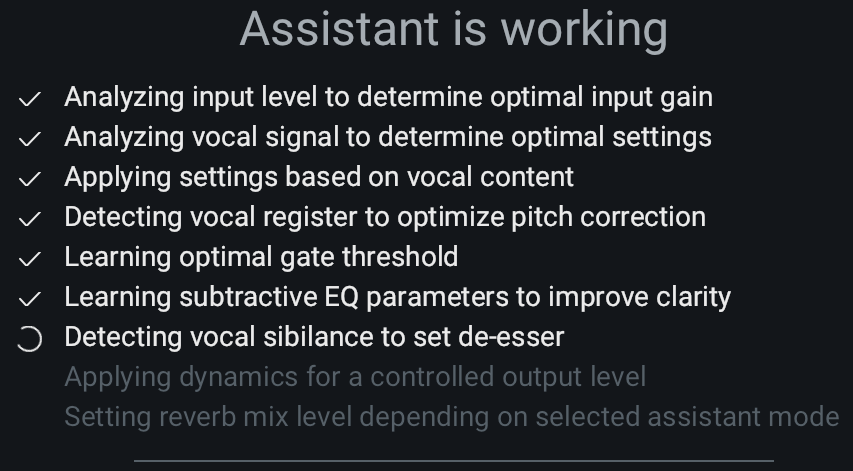
Assist runs through the following steps during analysis:
- Analyzing input level to determine optimal input gain: Enables ALM mode and adjusts the input gain to ensure an optimal input level.
- Analyzing vocal signal to determine optimal settings: Analyzes your vocal to identify characteristics that will inform the processing applied in the subsequent steps.
- Applying settings based on vocal content: Applies an initial “character” EQ curve and Dynamics settings. These settings are based on a combination of the Vibes and Intensity selections and the results of vocal content analysis.
- Detecting vocal register to optimize pitch correction: Analyzes pitch information in your vocal track and uses that information to set the Vocal Register for pitch correction processing.
- Learning subtractive EQ parameters to improve clarity: Learns the frequency content of your vocal and sets subtractive EQ bands to frequency values that will help to improve clarity.
- Detecting vocal sibilance to set de-esser: Analyzes the frequency content of your vocal for harsh, sibilant frequency content. If sibilance is detected, Vocal Assistant will set the optimal cutoff frequencies and threshold value for De-esser.
- Applying dynamics for a controlled output level: Configures Compressor settings in order to control the output level of your vocal.
- Setting reverb mix level depending on selected assistant mode: Applies a subtle Reverb to your vocal to add a sense of space.
When the Assist analysis pass completes, Vocal Assistant will begin Unmask analysis (if Unmask is selected in the first Vocal Assistant screen).
Unmask Analysis
After Assist analysis has completed, Unmask analysis will begin.

Unmask analysis listens to the selected source and the current vocal track and compares them to detect the presence of masking.
If no significant masking is detected between the vocal and the Unmask source, the final Unmask step will state “No significant masking detected” and no EQ curve will be applied to the selected source plug-in.
If masking is detected, an EQ curve will be applied to the instance you selected in the Unmask dropdown.
Plug-ins that are unmasking Nectar will update to display an “Unmask” indicator and power button above the I/O level meters.

You can enable/disable Unmask by opening the source plug-in and toggling the power button to the left of the “Unmask” indicator.
If you are using NECTAR PLUS, you’ll have access to Advanced Unmask Controls in the source plug-in.
Advanced Unmask Controls
NECTAR PLUS ONLYExtended Unmask options are available in the selected source plug-in when they are unmasking the PLUS edition of Nectar.
A down arrow will appear on the right side of the Unmask indicator of a source plugin when advanced unmask controls are available.

Click on the Unmask indicator to expand the advanced unmask panel.
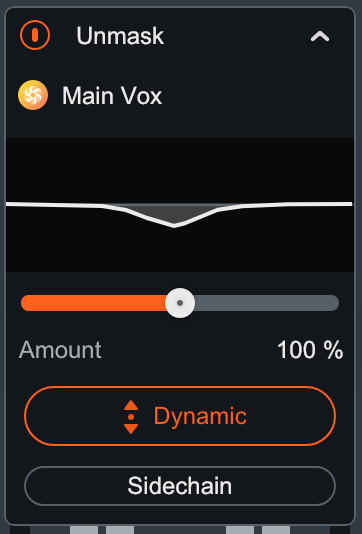
The advanced unmask panel includes:
- NAME: The Nectar Plus instance that is being unmasked.
- UNMASK EQ CURVE DISPLAY: Displays the unmask EQ curve being applied to the Nectar instance. Hover your cursor over the EQ curve to display EQ frequency and gain values.
- AMOUNT: Scales the intensity of unmask EQ cuts.
- DYNAMIC: Enables/disables dynamic unmask EQ.
- When enabled, unmask EQ cuts will be applied when the masking signal exceeds a fixed threshold. The EQ curve display will animate to reflect changes to the EQ curve when Dynamic mode is enabled.
- SIDECHAIN: Only available when Dynamic mode is enabled. Sets the dynamic EQ detection input to the sidechain input source configured for the plug-in.
Apply Settings
To apply the results of Vocal Assistant, click the “Accept” button.
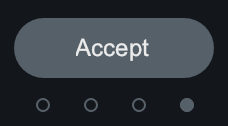
To re-run Vocal Assistant processing before applying settings, click the back button.

To exit the Vocal Assistant screen without applying any changes, click the x button.

Compressor
Overview
A compressor can be used to reduce dynamic range, maintain consistent levels, and shape the tone and character of a vocal track. Nectar 3 includes two Compressor modules that can be placed in series within the module chain, allowing for a variety of vocal compression configurations. The Compressor modules include controls for adjusting the amount, speed, and character of processing and robust metering for visualizing the effect of processing.

Controls
The controls in the Compressor module work together to influence the character, amount, and speed of the compression applied to the input signal. The following controls are available in the Compressor module:
Mode
Determines the processing algorithm used by the Compressor. There are four unique mode options available: Digital, Vintage, Optical, and Solid-state. The Mode selection influences the character of compression and will also determine the ranges of the Ratio, Attack, and Release controls.

The following table describes the sonic characteristics and associated control ranges for each of the compressor modes.
| Mode | Description |
|---|---|
Digital 
|
Modern, surgical compression. Ideal for achieving precise, clean sounding linear compression with minimal coloration.
|
Vintage 
|
Classic, analog compression. Emulates the program-dependent response and non-linear release characteristics of classic analog compressors.
|
Optical 
|
Smooth and transparent compression with subtle coloration. Emulates the subtle harmonic coloration and non-linear attack and release characteristics of classic hardware optical compressors.
Tip Use RMS level detection mode (rather than Peak level detection) to more faithfully emulate the sound of hardware optical compressors, which utilized RMS level detection. |
Solid-State 
|
Clear but aggressive compression with unique harmonic coloration. Emulates the fast attack, non-linear release times and harmonic characteristics of early VCA transistor-based hardware compressors. Solid-state mode can be useful for accentuating vocal transients.
Tip Use Peak level detection mode (rather than RMS level detection mode) to best highlight the pleasing harmonic coloration effect of the Solid-state algorithm. |
Level Detection Mode
The Level Detection Mode determines how input levels are calculated by the compressor. Adjusting the level detection mode will alter the level that is considered by the threshold, which will affect when or how often the input level will trigger compression.

The Compressor includes two level detection modes: Peak and RMS.
- Peak: Determines input level to the compressor using instantaneous peak levels of the incoming signal.
- RMS (Root Mean Square): Determines input level to the compressor by averaging levels of the incoming signal.
Threshold
Determines the signal level at which the compressor begins processing.

When the input level exceeds the threshold level, the compressor will be triggered. Signals that exceed the threshold level will be reduced according to the Ratio. The attack phase of the compressor begins when the input level exceeds the threshold level. The release phase of the compressor begins when the input level falls below the threshold level.
Tip: Adjusting the Threshold
- Click and drag the Threshold slider handle up (to increase the Threshold) or down (to decrease the Threshold).
- Click on the Threshold value readout text and manually enter a value in the inline edit field.
Tip: Using the waveform displays when setting threshold
You can use the waveform displays as a visual guide when setting the threshold level for the compressor.
Ratio
Determines how much gain reduction will be applied to signals that exceed the threshold level. When ratio is set to a value of 1:1, no attenuation will be applied to signals that exceed the threshold. Ratio settings of 10:1 or greater allow the compressor to function as a limiter. Limiting ratios can be used to ensure that the output signal level does not exceed the threshold level.
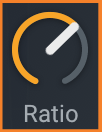
Optical Mode Ratio Setting
When Optical mode is selected, the Ratio control is fixed to 4:1.
Attack
Adjusts the amount of time it takes for the compressor to apply gain reduction when the input signal exceeds the threshold. Attack time can be adjusted in increments of milliseconds (ms).
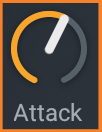
Release
Adjusts the amount of time it takes for the compressor to stop processing when the input signal falls below the threshold. Release time can be adjusted in increments of milliseconds (ms) and are typically longer than attack times.

Makeup Gain
Determines the amount of static gain applied to the output signal after compression.
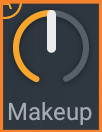
Auto Gain
Automatically adjusts the gain of the compressed signal in order to match the level of the input signal.

Global Module Controls
The module chain features common controls for each module, including: Bypass, Solo, Remove, Reorder, and Wet/Dry Mix.

Global Controls Chapter
To learn more about the module chain and other global controls in Nectar 3, visit the Global Controls chapter.
Meters
The following meters illustrate how the Compressor is responding to and processing the input signal:
Waveform Displays
The scrolling waveform meters display the amplitude of the input (uncompressed) and output (compressed) signals over time. The meters scroll from right to left, with the most recent information on the right.
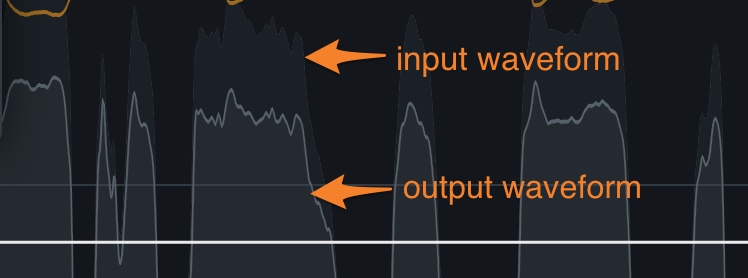
The compressed output signal waveform is displayed in light grey, in front of the input signal waveform. The uncompressed input signal waveform is displayed in dark grey, behind the output signal waveform. When the signal is being compressed, the gain reduction applied to the output signal can be observed in the difference between the two waveforms.
Note: Auto gain in the output waveform
Auto gain adjusts the level of the compressed signal to compensate for any level difference between the uncompressed and compressed signals. The gain change introduced by auto gain is reflected in the output waveform, which may make it more difficult to differentiate between the input and output waveforms. The gain reduction trace meter can be useful for monitoring gain reduction over time when auto gain is enabled.
Gain Reduction Trace
The yellow trace line indicates the gain reduction applied by the compressor over time. The trace can be used to monitor the response times (attack and release phases) and gain reduction applied over time.
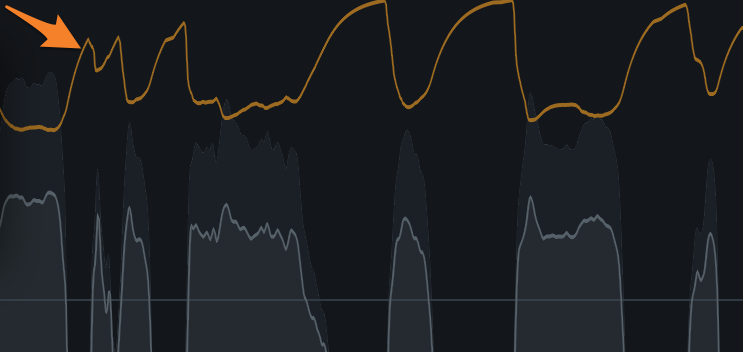
Gain Reduction Meter
Displays the current average amount of gain reduction applied to the signal. This meter displays gain reduction in decibels (dB).

De-esser
Overview
A de-esser can be used to control sibilance and tame other high frequency issues in a vocal track. Traditionally, a de-esser dynamically reduces loud sibilant content using a threshold and ratio. The Nectar De-esser module is a hardware-modeled level independent processer, allowing for consistent and transparent reduction of sibilance in signals with variable levels, like a vocal track. The De-esser works by analyzing the current level above a specified frequency cutoff and comparing that level against the level of the full frequency bandwidth of the signal. When large differences in level are detected, gain reduction will be applied to the entire incoming vocal signal.
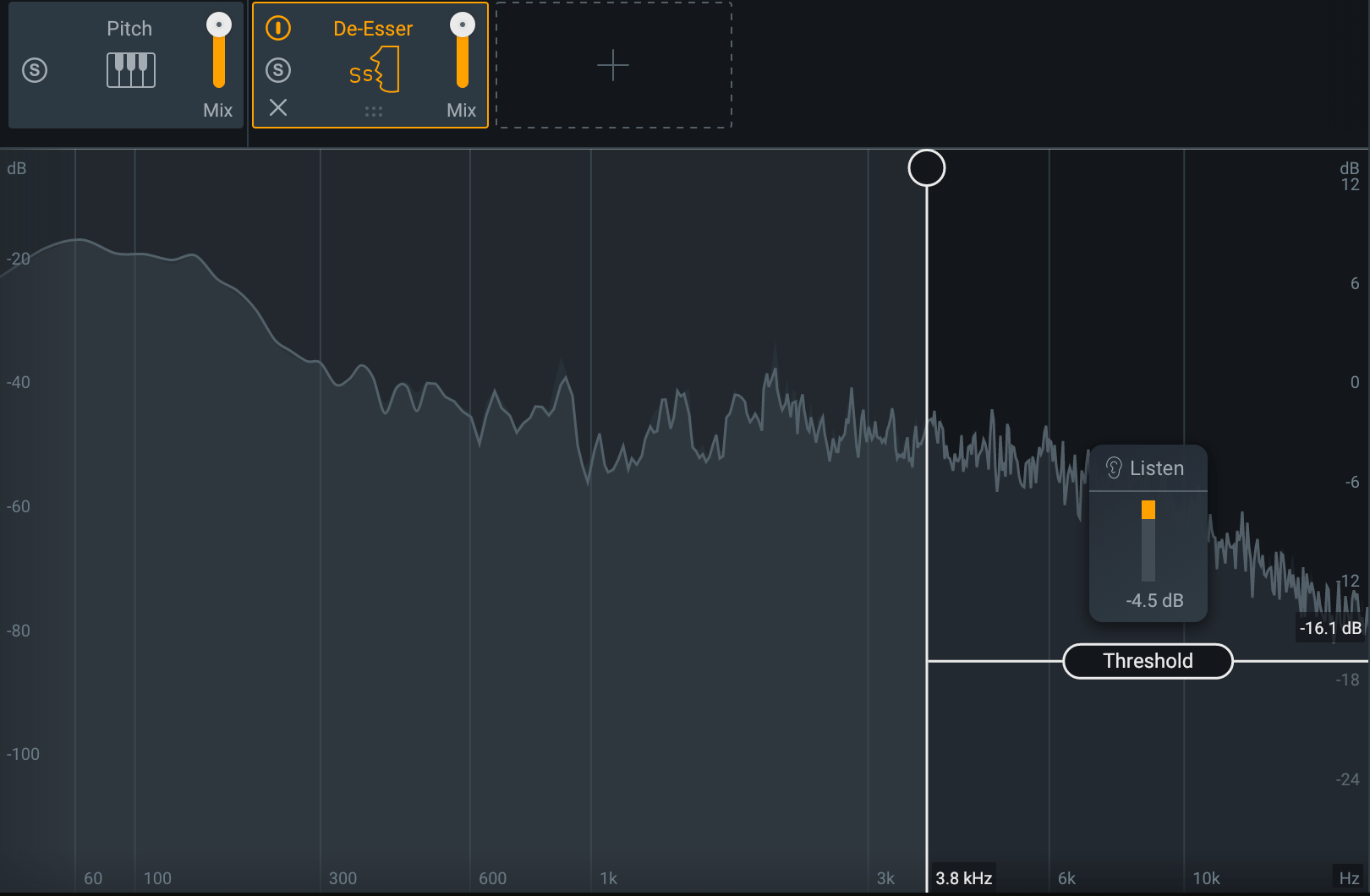
Controls
The De-esser module includes controls for adjusting the detection and reduction of sibilant frequency content. The controls are positioned on the right side (upper frequency range) of the De-esser module panel.
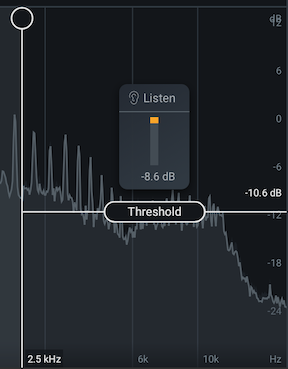
Detection Filter Cutoff
Determines the lower frequency boundary for the detection filter frequency band. Any frequency content that is above the cutoff frequency will be used for De-esser detection.
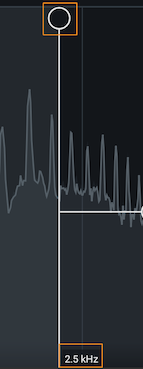
The detection filter cutoff can be set to frequency values ranging from 800 Hz (Hertz) to 8 kHz (kilohertz).
Adjusting the Detection Cutoff Frequency
The detection filter cutoff frequency can be adjusted using the following methods:
- Click and drag the node at the top of the De-esser module panel to the left (lower frequency value) or right (higher frequency value).
- Click on the cutoff frequency text readout display and enter a value manually in the inline edit field. The current frequency readout is located on the bottom edge of the De-esser module panel, to the right of the Detection Cutoff Frequency line.
- Double-click on the cutoff node handle to reset the Detection Cutoff Frequency to the factory default value.
Threshold
Determines the threshold level for ess reduction and the amount of gain reduction applied to the incoming signal when sibilance is detected.

When sibilance is detected and its level exceeds the Threshold level, the De-esser will apply reduction to the entire bandwidth of the incoming signal.
The amount of reduction applied to the signal depends on how much the sibilance level exceeds the Threshold. More gain reduction will be applied as the sibilance level increases farther above the Threshold level.
Adjusting the Threshold
The Threshold can be adjusted using the following methods:
- Click and drag the Threshold handle up and down to adjust the level.
- Click on the Threshold level readout text and enter a value manually in the inline edit field. The Threshold level readout is located on the right edge of the De-esser module panel, directly above the Threshold line.
- Double-click on the Threshold slider handle to reset the Threshold to the factory default value.
Listen
When enabled, the signal content that is being reduced by the De-esser is played back in isolation.

Tip
Engage Listen to monitor the difference between the unprocessed and processed signals. This outputs only the signal content being reduced by the De-esser. Try adjusting the Threshold and Detection Filter Cutoff until the Listen output only contains the ess sounds you are trying to reduce.
Global Module Controls
The module chain features common controls for each module, including Bypass, Solo, Remove, Reorder, and Wet/Dry Mix.
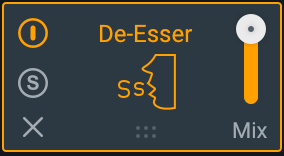
Global Controls Chapter
To learn more about the module chain and other global controls in Nectar 3, visit the Global Controls chapter.
Meters
The De-esser module features two spectrum analyzers (pre- and post-processing) and a gain reduction meter for monitoring the effect of the De-esser processing.
Spectrum Analyzer
Displays the magnitude of a signal across the frequency spectrum in real-time. The vertical ruler on the left edge of the module panel measures the amplitude of the signal in decibels (dB). The horizontal ruler along the bottom edge of the module panel measures frequency in Hertz (Hz).
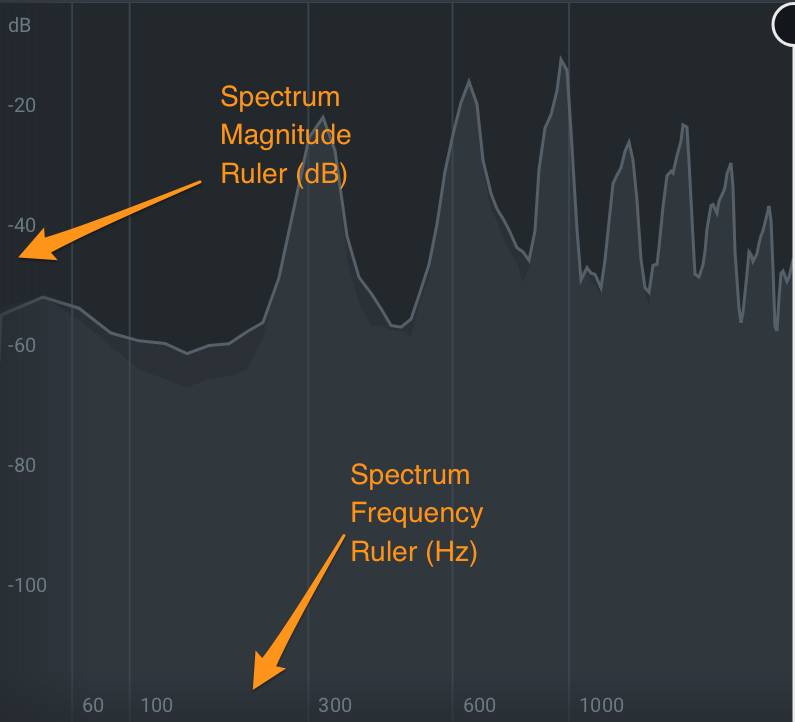
Two spectrum analyzers are displayed in the De-esser module: the input to the De-esser module (displayed in dark grey with no border) and the output of the De-esser module (displayed in light grey with a white border).
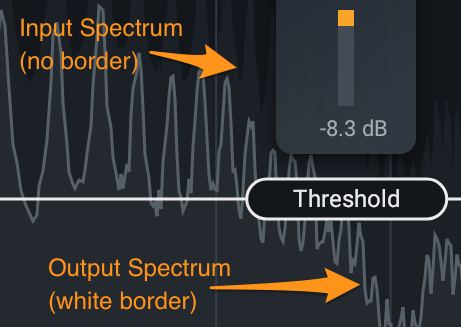
Gain Reduction Meter
Displays the current average amount of gain reduction applied to the signal. This meter displays gain reduction in decibels (dB).
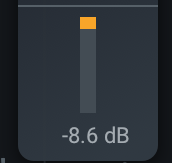
Delay
Overview
Delay can be used to thicken and add a sense of space to a vocal track. The Delay module features stereo delay processing with five distinct saturation modes and modulation options.

Controls
The Delay module controls panel includes parameters for customizing the timing and character of the delay effect.

The Delay controls panel includes the following groups of parameters:
Delay Controls
The Delay module offers different controls depending on the channel count of the track that Nectar 3 is inserted on.
- MONO: When Nectar 3 is inserted on a mono track, a single set of delay controls (Delay, Tempo Sync, and
Feedback) are available in the Delay module controls panel.

- STEREO: When Nectar 3 is inserted on a stereo track, two sets of delay controls (Delay, Tempo Sync, and
Feedback) are available in the Delay module controls panel, allowing for independent or linked adjustment of
left and right channel delays.

Delay
Determines the amount of time between each successive repeat of the incoming signal.
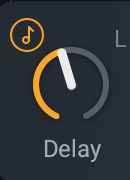
When Tempo Sync is disabled for the associated channel, the Delay control will be adjusted in increments of milliseconds (ms), ranging from 1ms to 3500ms.
Tempo Sync
When enabled, the Delay control will be adjusted in increments of musical note values. The duration of the musical note value is based on the tempo of the session.

When Tempo Sync is enabled, the Delay control supports note values ranging from 1/64T (fast - shortest delay between repeats) to 8. (slow - longest delay between repeats).
Example: Tempo Sync Note Durations
- When the session Tempo is set to 120 BPM: The duration of a quarter note is 500 milliseconds, meaning the input signal will be delayed for 500ms before repeating.
- When the session Tempo is set to 220 BPM: The duration of a quarter note is 273 milliseconds, meaning the input signal will be delayed for 273ms before repeating.
Feedback
Determines the amount of delayed signal that is fed back into the input of the delay.

Link
Enables channel linking of delay control values when the Delay module is instantiated as a stereo effect.

Note: Right Channel Link Behavior
When Link is enabled, the right channel Delay and Feedback values will snap to match the left channel values. When Link is disabled, the right channel controls will snap back to the values set before enabling Link.
Saturation
The Delay control panel includes parameters for adjusting the saturation mode and amount.
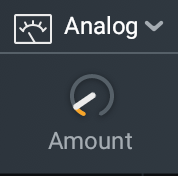
Mode
Determines the type of saturation effect applied to the delayed signal.
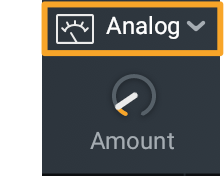
The following table outlines the sonic characteristics of the different saturation modes.
| Mode | Characteristics |
|---|---|
Digital
|
Transparent, clean delay. Provides exact copies of the incoming signal with minimal coloration. |
Tape
|
Classic, colorful drive. Filters and distorts each progressive repeat in the way a signal would be degraded over time on magnetic tape. |
Analog 
|
**Gritty, distorted edge.** Based on circuit distortion, can lend gritty edge to the delayed signal. |
Grunge
|
**Dirty, degraded character.** Adds post-feedback crunchy drive to the delayed signal. |
Echo
|
**Pronounced presence boost.** Repeats and fades out tape saturated copies for adding creative depth and impactful presence. |
Amount
Adjusts the amount of drive applied to the saturation.
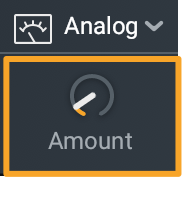
Modulate
Enables Rate and Depth parameters for adjusting LFO modulation of delay time.
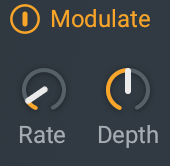
- Rate: Determines the speed of the LFO modulation, i.e how often the delay time is modified by the LFO.
- Depth: Determines the intensity of LFO modulation, i.e. how much the delay time is modified from the baseline Delay time value.
Post Filter
The highpass and lowpass filters in the Delay module allow for undesirable low and high frequency content to be filtered out of the processed signal.

Post Filter
- The high and lowpass filters in the Delay module are only applied to the wet (processed) output of the module.
- Click and drag the filter node left and right to adjust frequency.
Global Module Controls
The module chain features common controls for each module, including: Bypass, Solo, Remove, Reorder, and Mix.

Global Controls Chapter
To learn more about module chain and other global controls in Nectar 3, visit the Global Controls chapter.
Meters
The Delay module features two spectrum analyzers for monitoring the effect of processing.
Spectrum Analyzer
Displays the magnitude of a signal across the frequency spectrum in real-time. The vertical ruler on the left edge of the module panel measures the amplitude of the signal in decibels (dB). The horizontal ruler along the bottom edge of the module panel measures frequency in Hertz (Hz).

Two spectrum analyzers are displayed in the Delay module: the input to the Delay module (displayed in dark grey, with no border) and the output of the Delay module (displayed in light grey with a white border).

Dimension
Overview
A modulation effect (e.g. chorus, flanger, or phaser) can be used to add depth and movement to a vocal track. Modulation effects work by duplicating an input signal, modifying an aspect of the duplicated signal using an LFO (low frequency oscillator) and then mixing the original and modified signals together. The effect modes in the Dimension module allow for a range of subtle to wacky vocal modulation effects.

Controls
The Dimension module controls panel includes parameters for customizing the different modulation effects.

The following parameters are available in the Dimension controls panel:
- Effect Modes
- Modulation Controls
- Width
- Freq (Only available in Phaser effect mode)
Effect Modes
The Dimension module includes three different modulation effects, Chorus, Flanger and Phaser. The effect mode can be changed using the buttons on the left side of the Dimension controls panel.

The following table describes how the different effect modes apply processing to an input signal.
| Mode | Description |
|---|---|
Chorus 
|
Chorus effects work by creating a delayed copy of a signal and modulating the delay with an LFO (low frequency oscillator). This results in gradual changes to the pitch of the copied signal. The modified signal and the input signal are mixed back together to create a pitch-modulated doubling effect, simulating the effect of two or more performers singing in unison. |
Flanger 
|
Similar to a Chorus, Flangers work by creating a delayed copy of a signal and modulating the delay with an LFO (low frequency oscillator). The modified signal and the input signal are then mixed together, resulting in a sweeping comb filter effect. Flanger delay times are shorter than chorus delay times. |
Phaser 
|
Phasers work by applying an all-pass filter to a copy of the input signal, creating a series of notches across the frequency spectrum. The positions of the frequency notches are modulated with an LFO (low frequency oscillator). The input signal and modulated signal are mixed together to create a sweeping effect. Unlike flanger and chorus effects, Phasers do not use delay to modify the signal. |
Want to learn more about modulation effects?
Check out this iZotope blog post: Understanding Chorus, Flangers, and Phasers in Audio Production
Modulation Controls
The controls in the center of the Dimension module controls panel adjust the rate and depth of LFO modulation, as well as the amount of processed signal that is fed back into the input of the effect.

Rate
Determines the speed of the LFO modulation. When Chorus or Flanger effect modes are selected, the Rate control determines how often the delay time is modified. When the Phaser effect mode is selected, the rate control determines how often the filter positions are modified.

When Tempo Sync is disabled, the Rate control range extends from 0.01 Hz (slow - longest modulation cycle) to 4.00 Hz (fast - shortest modulation cycle).
Tempo Sync
When enabled, the Rate control can be adjusted in increments of musical note values. The duration of the musical note value is based on the tempo of the session.
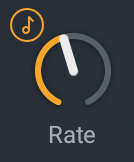
When Tempo Sync is enabled, the Rate control supports note values ranging from 1/64T (fast - shortest modulation cycle) to 8. (slow - longest modulation cycle).
Example: Tempo Sync Note Durations
- When the session Tempo is set to 120 BPM: The duration of a quarter note is 500 milliseconds, meaning the LFO will complete a cycle once every 500ms.
- When the session Tempo is set to 220 BPM: The duration of a quarter note is 273 milliseconds, meaning the LFO will complete a cycle once every 273ms.
Depth
Determines the intensity of LFO modulation. When Chorus or Flanger effect modes are selected, the Depth control determines how much the delay time between signals is modified from the default delay value. When the Phaser effect mode is selected, the Depth control determines how much the filter positions are modified from the default filter positions.
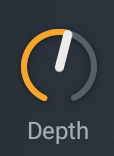
The Depth control range extends from 0% (effectively no modulation) to 100%.
Width
Determines the amount of stereo widening applied to the output of the modulation effect.
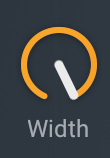
The Width control range extends from 0% (no stereo widening) to 100%.
Freq
Determines the starting frequency of the all-pass filter applied by the Phaser.

Note
The Freq control is only enabled when the Phaser effect mode is selected.
Global Module Controls
The module chain features common controls for each module, including Bypass, Solo, Remove, Reorder, and Wet/Dry Mix.

Global Controls Chapter
To learn more about the module chain and other global controls in Nectar 3, visit the Global Controls chapter.
Meters
The Dimension module features two spectrum analyzer displays for monitoring the effect of processing.
Spectrum Analyzer
Displays the magnitude (level) of a signal along the frequency spectrum in real-time. The vertical ruler on the left edge of the module panel measures the amplitude of the signal in decibels (dB). The horizontal ruler along the bottom edge of the module panel measures frequency in Hertz (Hz).

Two spectrum analyzers are displayed in the Dimension module: the input to the Dimension module (displayed in dark grey, with no border) and the output of the Dimension module (displayed in light grey, with a white border).

EQ
Overview
An equalizer can be used to enhance the tone and character of a vocal track by adjusting the level of specific frequencies. Nectar 3 includes two EQ modules with support for adding up to 24 highly customizable bands. Each band includes 16 different filter shapes and two program dependent processing modes: Dynamic Frequency mode for dynamically updating the frequency of a filter in response to harmonic frequency content changing over time, and Dynamic Gain mode for dynamically adjusting the gain of a filter in response to the input signal.

Interactions
Add Bands
Bands can be added to the EQ using the following methods:
- Click on the + button that appears when hovering the mouse cursor over the white composite
curve line in the EQ display.
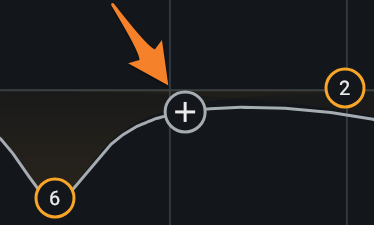
- Single-click to place a new node in the location of the click.
- Click and drag on the + button to quickly add a node and drag it to a new position.
- Double-click anywhere in the EQ spectrum display to add and position a new node in the location of the click.
- Double-click and drag to quickly position the node in the location of the click, and drag it to a new position.
- Use Command+Return (Mac) or Control+Return (Windows) to add a new node to the center of the EQ spectrum.
Remove Bands
Bands can be removed from the EQ using the following methods:
- Select a node and click the x button in the band controls panel to remove it.
- Click and drag over nodes in the EQ spectrum panel to select multiple nodes. Use the delete or backspace key to remove all selected nodes.
- Shift-click to select multiple nodes. Use the delete or backspace key to remove all selected nodes.
Alt-Solo
The EQ module includes an Alt-Solo feature that allows frequency bands to be played back in isolation without affecting any EQ settings.
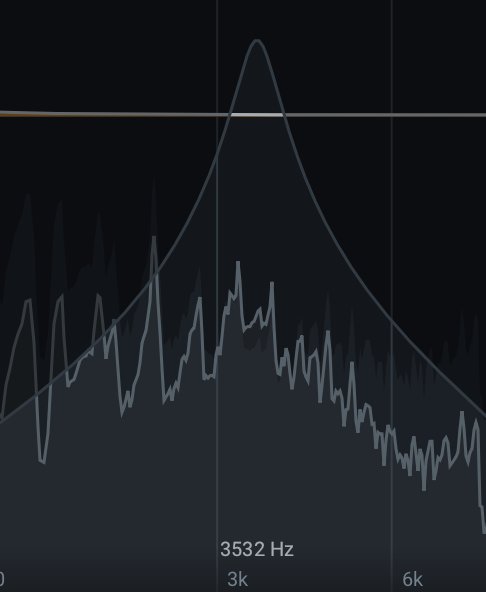
Alt-Solo can be enabled by holding the Alt/option key when clicking anywhere in the EQ spectrum to solo the frequencies surrounding the location of the click.
Alt-Solo Q
The Q (bandwidth) of the Alt-Solo filter can be adjusted in the Options window.
Controls
To access the band controls panel for a given band, click on the corresponding node in the EQ module panel.
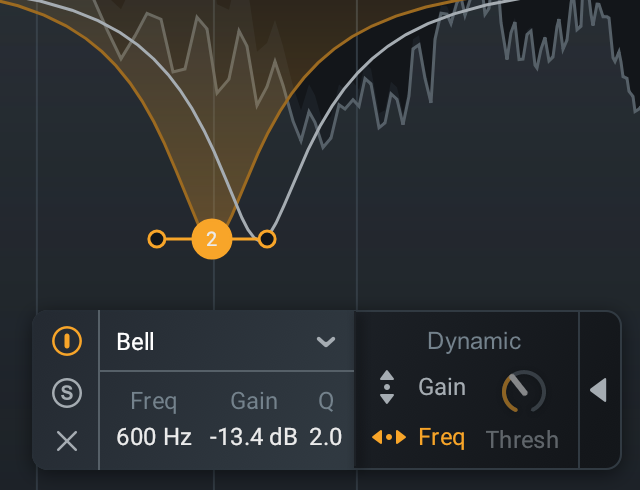
The following controls are included in the band controls panel:
General Band Controls
The left side of the band controls panel includes parameters for enabling/disabling, soloing, and removing the currently selected band.
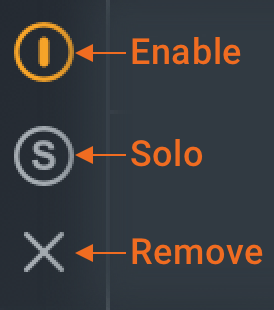
Enable
Enables or disables processing of the currently selected band.
Note
When a band is disabled, the filter will still be displayed in the EQ module panel. Disabled bands are displayed in grey to clearly differentiate them from enabled bands.
Solo
Enables temporary cutoff filters that allow frequencies within the bandwidth of the selected filter to be listened to in isolation.
Tip: Solo Band Shortcut
Hold the Alt and click on an EQ node to quickly engage the band Solo functionality.
Remove
Removes the currently selected band.
Frequency
Determines the center frequency (or cutoff frequency) (Hz) of the currently selected node. The EQ supports frequency values ranging from 20 Hz to 20 kHz.
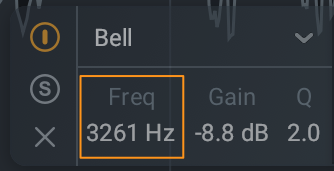
Tips: Adjusting EQ filter Frequency
The Frequency of an EQ band can be modified using the following methods:
- Click and drag an EQ node to the left (to reduce the frequency value) or right (to increase the frequency
value).
- Hold Shift while dragging a node to the left or right to lock the movement of the node to the horizontal axis.
- Double-click on the Frequency value readout and manually enter a Frequency value in the inline edit field.
- Select a node and use the Left arrow key to decrease Frequency or use the Right arrow key to increase
Frequency.
- Hold the Shift modifier key to make coarse value adjustments.
- Hold the Command (Mac) or Ctrl (Windows) modifier key to make fine value adjustments.
Gain
Determines the amount of gain (dB) applied by the selected filter. The EQ supports gain adjustments ranging from -30 dB to +15 dB.
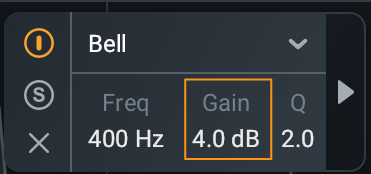
Tips: Adjusting EQ filter Gain
When available for adjustment, the Gain of an EQ band can be modified using the following methods:
- Click and drag an EQ node up (to increase gain) or down (to decrease gain).
- Hold Shift while dragging a node up or down to lock the movement of the node to the vertical axis.
- Double-click on the Gain value readout and manually enter a Gain value in the inline edit field.
- Select a node and use the Up arrow key to increase Gain or use the Down arrow key to decrease Gain.
- Hold the Shift modifier key to make coarse value adjustments.
- Hold the Command (Mac) or Ctrl (Windows) modifier key to make fine value adjustments.
- Double-click on a node to reset the Gain and Q/Slope to their default values.
EQ Gain Scale
The vertical dB magnitude scale on the right edge of the EQ module panel measures the EQ filter Gain.
Bandwidth
Determines the width or slope (dB/octave) of the selected filter. Bandwidth is labeled as either Q or Slope in the band controls panel, depending on the selected filter shape.
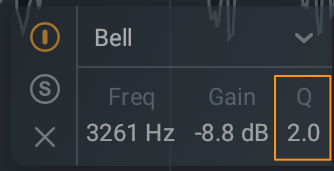
Tips: Adjusting EQ filter Q/Slope
The Q/Slope of an EQ band can be adjusted using the following methods:
- Click and drag the node handles toward the node to decrease the bandwidth.
- Click and drag the node handles away from the node to increase the bandwidth.
- Double-click on the Q/Slope value readout and manually enter a Q/Slope value in the inline edit field.
- Hover the cursor over the node and use the mousewheel to adjust the Q/Slope value.
- Select a node and use Alt/Option+Left Arrow Key to decrease the bandwidth or use Alt/Option+Right
Arrow Key to increase the bandwidth.
- Hold the Shift modifier key to make coarse value adjustments.
- Hold the Command (Mac) or Ctrl (Windows) modifier key to make fine value adjustments.
- Double-click on a node to reset the Gain and Q/Slope to their default values.
Filter Types
The EQ module features 16 different filter shapes, each one belonging to one of the following filter type categories:
Pass Filter
Pass type filters are used to attenuate frequency content that is below (in the case of a high pass) or above (in the case of a low pass) a specified cutoff frequency. The degree of attenuation applied to content above or below the cutoff is determined by the slope of the filter. The EQ module includes four Pass type filter shapes in the Highpass and Lowpass sub-menus.
Peak Filter
Peak type filters are used to boost or cut the level of a specific center frequency. The amount of boost or cut applied to frequencies surrounding the center frequency is determined by the Q (or “Bandwidth”) of the filter. The EQ module includes four Peak type filter shapes in the Bell sub-menu.
Shelf Filter
Shelf type filters are used to boost or cut the frequency content above or below a specified frequency by the same amount. The EQ module includes Shelf type filter shapes in the Low Shelf and High Shelf sub-menus.
Filter Shape
Determines the filter shape of the currently selected band.
The filter shape dropdown menu organizes the filter shapes into the following sub-menus: Bell, Low Shelf, High Shelf, Lowpass, and Highpass.

Bell
The Bell sub-menu includes the following Peak type filters:

|
Filter Shape | Description |
|---|---|---|

|
Bell | Smoothly boosts or cuts an adjustable region around a specific frequency. Looks like a bell, come on what do you want from me. |

|
Proportional Q | Unique filter that varies shape in proportion to the amount of boost or cut applied. As a cut or boost is increased further away from center of the EQ curve, the shape tightens for more precision. |

|
Vintage | Asymmetrical bell filter that is more narrow when cutting frequencies than when boosting frequencies. |

|
Band Shelf | Bell filter with wide, flat top. Useful for boosting or attenuating a block of frequencies. |
Low Shelf
The Low Shelf sub-menu includes the following Shelf type filters:

|
Filter Shape | Description |
|---|---|---|

|
Analog | Efficient shelf filter for simple boosts and cuts. |

|
Resonant | Exhibits a complimentary resonance at both ends of the filter slope creating a complex shape with one node. |

|
Vintage | Modeled after the renowned Pultec analog equalizer. Exhibits a complimentary frequency dip, creating a complex slope with one node. |

|
Baxandall Bass | Gentle low frequency shelf. Modeled after the Baxandall EQ, with the addition of freely adjustable frequency. |
High Shelf
The High Shelf sub-menu includes the following Shelf type filters:

|
Filter Shape | Description |
|---|---|---|

|
Analog | Efficient shelf filter for simple boosts and cuts. |

|
Resonant | Exhibits a complimentary resonance at both ends of the filter slope creating a complex shape with one node. |

|
Vintage | Modeled after the renowned Pultec analog equalizer. Exhibits a complimentary frequency dip, creating a complex slope with one node. |

|
Baxandall Treble | Gentle high frequency shelf. Modeled after the Baxandall EQ, with the addition of freely adjustable frequency. |
Highpass
The Highpass sub-menu includes the following Pass type filters:

|
Filter Shape | Description |
|---|---|---|

|
Flat | Butterworth filter; optimized for maximum flatness without ripple or resonance in the passband or stopband. |

|
Resonant | Filter equipped with a resonance control to emphasize the cutoff frequency with positive gain. |
Lowpass
The Lowpass sub-menu includes the following Pass type filters:

|
Filter Shape | Description |
|---|---|---|

|
Flat | Butterworth filter; optimized for maximum flatness without ripple or resonance in the passband or stopband. |

|
Resonant | Filter equipped with a resonance control to emphasize the cutoff frequency with positive gain. |
Dynamic Processing Modes
The dynamic processing modes can be accessed by selecting a node and clicking the arrow button on the right hand side of the band controls panel.
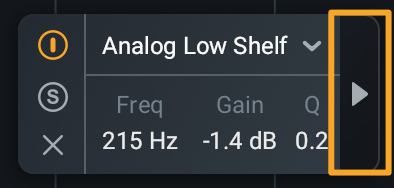
Note
If either of the dynamic processing modes are enabled for a given node, the arrow will appear orange when
the dynamic controls pop out panel is closed.
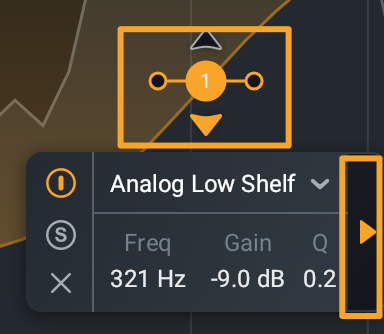
Dynamic gain or frequency processing can be enabled by clicking the Gain or Frequency buttons in the dynamic controls panel. Only one dynamic processing mode can be selected at a time for a selected band (i.e. Gain and Frequency mode cannot be enabled simultaneously for a selected band).

Gain Mode
Enables the ability to dynamically update the Gain of the selected EQ band when a signal exceeds the threshold level.
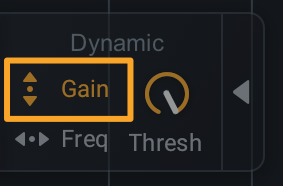
Clicking the “Gain” button in the EQ node controls panel will enable Dynamic Gain Mode for the selected node.
Note: Dynamic Gain Mode Availability
Dynamic Gain Mode is not available for Lowpass and Highpass filter shapes.
Boost or Cut Mode
When Gain mode is enabled, small triangle icons will appear directly above and below the associated EQ node. These icons indicate the expected direction of the dynamic gain change. Clicking on either triangle icon will determine the direction of gain change.

- BOOST: Selecting the upward facing triangle will increase the gain of the filter when signals exceed
the threshold level.
- When the EQ node is placed above the zero line, the filter will be set to 0 dB of gain until it is triggered. When it is triggered by incoming signals exceeding the threshold, the gain of the filter will be increased in the direction of the node.
- When the EQ node is placed below the zero line, the gain of the filter will be increased toward the zero line when it is triggered by incoming signals exceeding the threshold.
- CUT: Selecting the downward facing triangle will decrease the gain of the filter when signals exceed
the threshold level.
- When the EQ node is placed above the zero line, the gain of the filter will be reduced toward the zero line when triggered.
- When the EQ node is placed below the zero line, the filter will be set to 0 dB of gain until it is triggered. When it is triggered by incoming signals exceeding the threshold, the gain of the filter will be reduced in the direction of the node.
Threshold
Determines the signal level at which dynamic gain adjustments will be triggered for the selected EQ node.

Tip: Using Dynamic EQ to reduce sibilance
A dynamic EQ node can be used as an alternative to the De-esser module when attempting to reduce sibilant frequency content.
Frequency Mode
Enables the ability to dynamically update the Frequency of the selected EQ band to follow harmonics as they change.
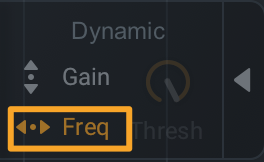
Frequency mode works by identifying the fundamental frequency of the input signal when Frequency mode is enabled for an EQ band. It then identifies the harmonic frequency that is closest to the frequency of the selected EQ band. When the fundamental of the incoming vocal changes over time, the frequency of the EQ band will dynamically update to follow that harmonic as it changes with the fundamental. When Frequency mode is enabled and the frequency of the EQ band is manually adjusted, the EQ band will update to track the harmonic closest to the new frequency value.
Tips: When to use Dynamic Frequency Mode
- Use a Highpass filter with Dynamic Frequency Mode enabled to track the first harmonic of a vocal. This will dynamically cut out unwanted low end rumble while maintaining the character of the vocal.
- Use multiple EQ bands with Dynamic Frequency Mode enabled to change the character of a vocal by following harmonics over time without the need for automation.
- Use a Bell filter with Dynamic Frequency Mode enabled to follow and cut harsh vocal resonances.
Global Module Controls
The module chain features common controls for each module, including: Bypass, Solo, Remove, Reorder, and Wet/Dry Mix.

Global Controls Chapter
To learn more about the module chain and other global controls in Nectar, visit the Global Controls chapter.
Meters
The following meters and displays are included in the EQ: Spectrum Analyzer, Composite Curve, and the Filter Response Curve.
Spectrum Analyzer
Displays the magnitude (amplitude, in decibels) of the input signal across the frequency spectrum in real-time. Two spectrum analyzers are displayed in the EQ module to compare the effect of processing. The input signal to the EQ module is shown as a dark grey spectrum with no border. The processed output spectrum is drawn in the foreground with a white border.

EQ Spectrum Rulers
- The vertical ruler on the left side of the EQ module panel measures the amplitude of the spectrum.
- The vertical ruler on the right side of the EQ module panel measures the gain of the EQ nodes.
- The horizontal ruler along the bottom of the EQ module panel measures the frequency.
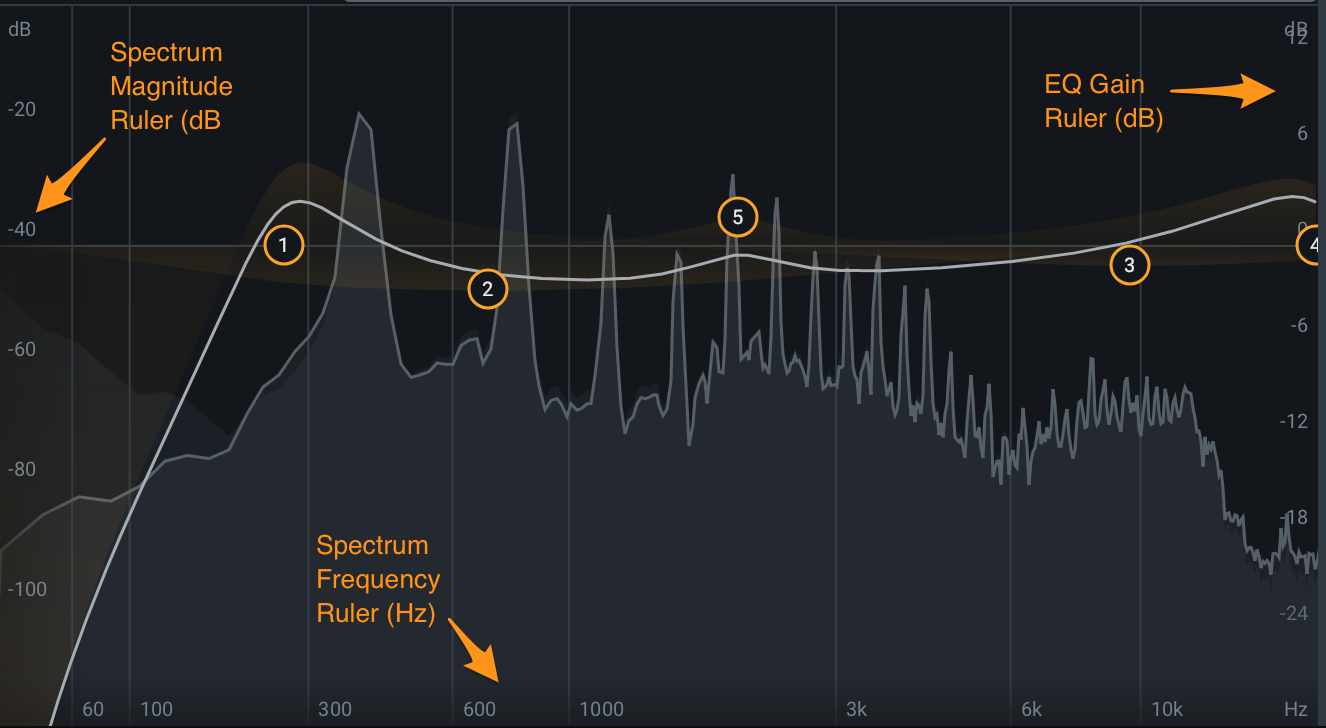
Composite Curve
The composite curve is the thick white line drawn across the EQ module panel. When EQ filters are added and modified they contribute to the overall shape of the composite curve. This curve represents the combined filter response of all enabled bands.
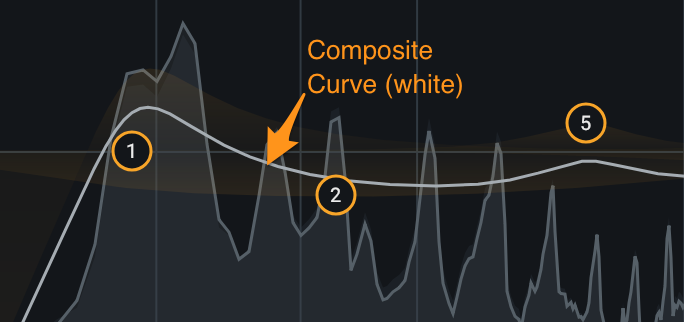
Filter Response Curve
The semi-transparent yellow fill color represents the filter response of a single band in isolation. This curve will be hidden by the white composite curve in cases where the selected filter shape is not affected by other enabled filters.

Gate
Overview
A gate can be used to attenuate undesirable signal content in the breaks between phrases of a vocal track. The Gate module provides an efficient and flexible alternative to manually editing or inserting silence between vocal phrases. The Gate includes controls for adjusting how and when processing is applied to the input, as well as robust metering to assist with determining the best control values and visualizing the effect of processing.

Controls
The controls in the Gate module work together to influence how the gate responds to the incoming signal. The following controls are available in the Gate:
Threshold
The Gate module features two threshold controls: the Open Threshold and Close Threshold.
Open Threshold
Determines the level above which the gate will open, allowing the signal to pass through. When the input signal falls above the Open threshold level, attenuation will stop.

Close Threshold
Determines the level at which the gate will close. When the input signal falls below the close threshold, it will be attenuated.
Move the close threshold down in order to pass more of the decay without affecting the trigger threshold. In some situations, undesirable signals that are near the level of the open threshold can cause the gate to “chatter” by crossing the threshold level too often. The Close threshold (also referred to as hysteresis) can be set a few dB below the Open threshold to help eliminate this chattering effect.

When a signal has dropped below the Close threshold, it will not trigger the gate to open again until it exceeds the level of the Open threshold.
Ratio
Determines the amount of gain reduction applied to signals that fall below the Close threshold.

Attack
Determines the amount of time (in milliseconds) it takes for the gate to transition from closed to open when a signal exceeds the Open threshold.

Release
Determines the amount of time (in milliseconds) it takes to transition from open to closed when a signal falls below the Close threshold.

Global Module Controls
The module chain features common controls for each module, including: Bypass, Solo, Remove, Reorder, and Wet/Dry Mix.

Global Controls Chapter
To learn more about the module chain and other global controls in Nectar, visit the Global Controls chapter.
Meters
The Gate module features scrolling waveform displays and a gain reduction meter for monitoring the difference between the processed and unprocessed signals.
Waveform Displays
The scrolling waveform meters display the amplitude of the input (ungated) and output (gated) signals over time. The meters scroll from right to left, with the most recent information on the right.

The processed output signal waveform is displayed in light grey, in front of the input signal waveform. The unprocessed input signal waveform is displayed in dark grey, behind the output signal waveform. When the signal is being gated, the gain reduction applied to the output signal can be observed in the difference between the two waveforms.
Gain Reduction Meter
Displays the current average amount of gain reduction in decibels (dB) applied to the signal.
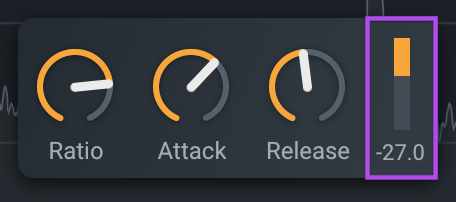
Harmony
Overview
A harmonizer can be used to build vocal harmonies by creating pitch-shifted copies of a vocal track. The Harmony module includes a node-based X/Y pad interface for easily adjusting the level, pan, pitch and timing of up to eight voices. The MIDI mode feature in the Harmony module allows for voices to be triggered by a MIDI controller.
Controls
The Harmony module panel includes general controls for adjusting processing applied to all voices, as well as an X/Y pad interface with controls for customizing individual voices.

The following parameters are available in the Harmony module panel:
Global Voice Controls
The right side of the Harmony module panel includes parameters that affect processing that is applied to all voices.

Set Scale
Determines the scale used for pitch correction processing in the Harmony module.

Clicking the Set Scale button will open the Pitch module. The Vocal Register and Scale settings on the left side of the Pitch module panel influence the pitch correction processing applied to the voices added by the Harmony module.
Shared Pitch & Harmony Settings: Scale & Vocal Register
The Vocal Register and Scale settings in the Pitch module panel are shared by the Pitch and Harmony modules. See the Pitch module chapter to learn more about the Vocal Register and Scale settings.
Voices Only
When enabled, the main voice will be muted and all voices created by the Harmony module will be played back in isolation.

Voices
The Voices section on the right side of the Harmony module panel includes controls for adjusting the amount of pitch correction, time variation and pitch variation applied to all voices generated by the Harmony module.

Pitch Correction
Adjusts the amount and character of pitch correction applied to the voices generated by the Harmony module.

Tip: Adjusting the Pitch Correction Control
- A Pitch Correction value of +100% will correct the voices to the selected scale.
- A Pitch Correction value of -100% will detune the voices.
Time Variation
Scales the amount of time offset applied to the generated voices.

Increasing this control can help to reduce phase cancellation in the generated voices, as well as increase the chorus-type effect of multiple performers singing the same part.
Pitch Variation
Scales the amount of pitch offset applied to the generated voices.

Increasing this control can help to humanize the character of the harmonies by varying the pitch of each voice slightly. It can also be used to reduce phase cancellation in the generated voices.
Filter
The small filter display on the right side of the Harmony module panel includes low and high shelf filter controls for shaping the output of the Harmony module.
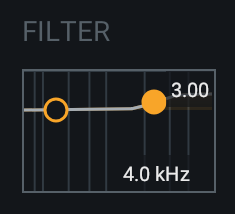
Note
The post filters are applied to the wet (processed) output signal of the Harmony module.
- To adjust the shelf filter values:
- Click and drag a filter node up and down to modify gain.
- Click and drag a filter node left and right to modify frequency.
MIDI Mode
Enables the ability to control the pitches of harmony voices using a MIDI controller or MIDI track.
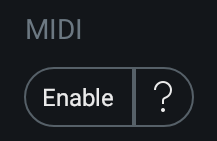
When MIDI mode is enabled, the nodes in the Voice XY Pad Controller will be highlighted when an incoming MIDI note is playing the voice. Voices are assigned to incoming MIDI notes in the order they are received. The voice node numbering determines which voice will be played first, the lowest available voice node number will be played first.
Example: MIDI Note Voice Assignment
For example, if four voice nodes are enabled in MIDI mode:
- When a single MIDI note is played, Voice 1 will be triggered.
- When a second MIDI note is played before the first note is released, Voice 2 will also be triggered.
- If the first note is released and a third note is played after it, Voice 1 will be triggered again.
Need help setting up MIDI mode?
Click on the ? button (to the right of the MIDI button in the Harmony module) to view a setup screen with steps for configuring MIDI mode in your DAW without leaving the plug-in.
Voice XY Pad Controller
The XY pad controller on the left side of the Harmony module panel allows for the adjustment and management of Voice nodes.
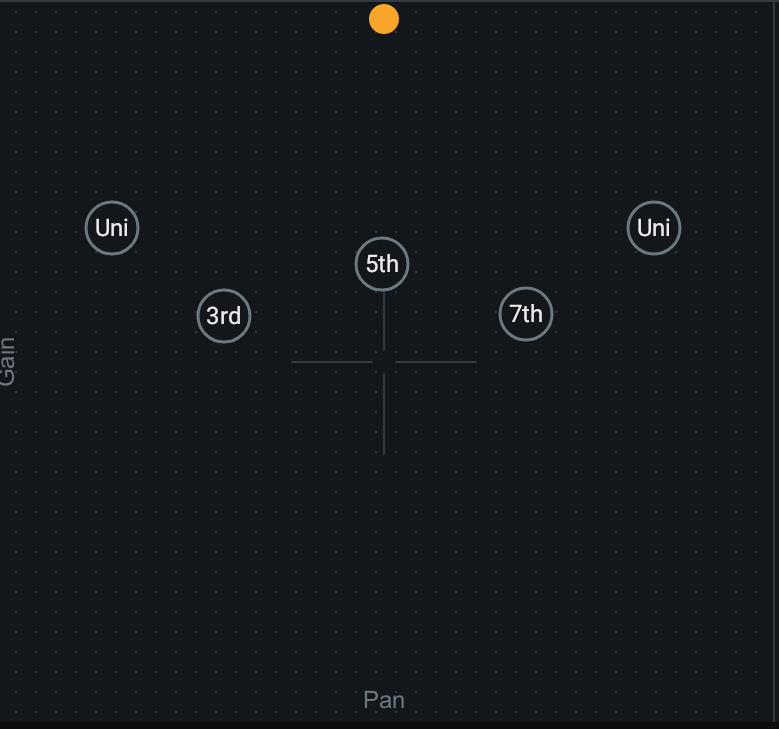
The x-axis (horizontal) of the XY pad represents the stereo pan position of a voice. The y-axis (vertical) represents the gain (level) of a voice.
Adding and Removing Voices
Voices can be easily added and removed from the XY pad. The Harmony module supports adding up to eight voices.
Add Voices
The following methods can be used to add voice nodes to the XY pad:
- Hover the cursor over the XY pad display and click on the + button to add a new node in the location of the click.
- Command+Return (Mac) or Control+Return (Windows) to add a new voice node.
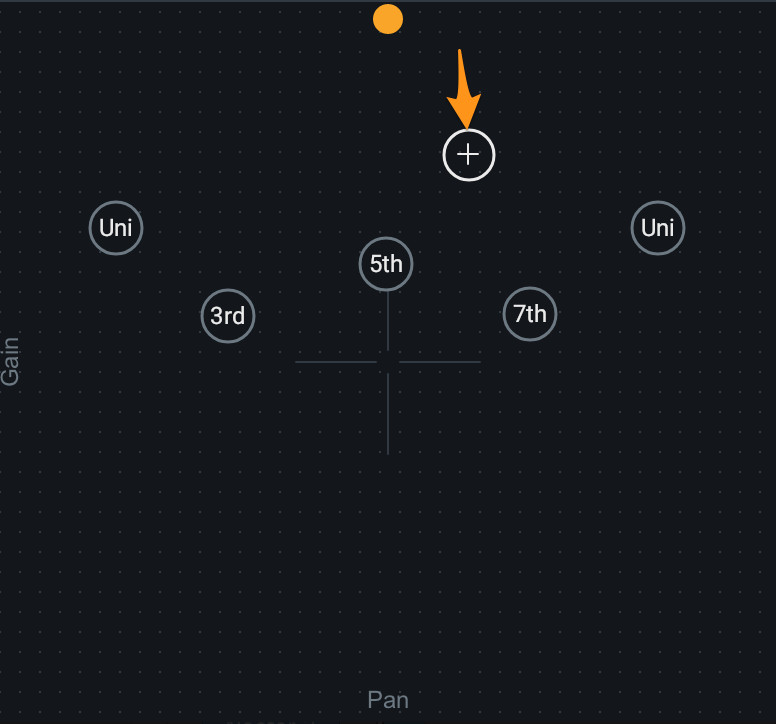
Remove Voices
The following methods can be used to remove voice nodes from the XY pad:
- Select a voice node and use the Delete or Backspace key on the keyboard to remove it.
- Select a voice node and click the x button in the voice node controls panel.
Tip: Quickly remove multiple nodes
Click and drag in the XY pad display to make a rectangular selection that selects multiple nodes. Remove all selected nodes using the delete or Backspace key on the keyboard.
Voice Node Controls Panel
The voice node controls panel appears when a node is selected in the Voice XY Pad Controller area.
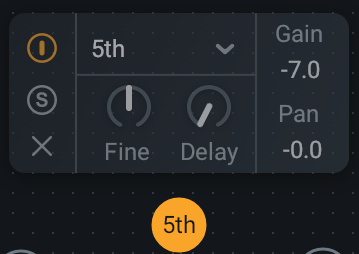
The following controls are included in the voice node controls panel:
General Voice Node Controls
The left side of the node controls panel includes parameters for enabling, disabling and soloing the currently selected voice node.
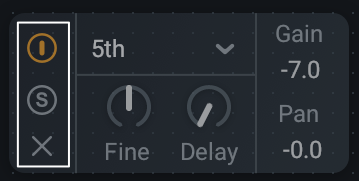
- Enable: Enables or disables processing of the currently selected voice.
- Solo: Outputs the currently selected voice in isolation.
Interval
Determines the musical interval of the generated voice in relation to the pitch of the main vocal.
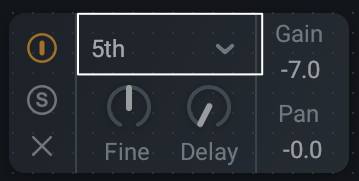
By default, the Interval is set to “Unison” to match the pitch of the generated voice to the pitch of the main vocal. The Interval setting allows for a range of -12 (one octave down) to +12 (one octave up).
Fine
Determines the amount of fine pitch adjustment applied to the selected voice.
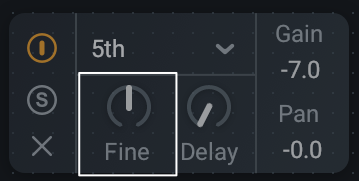
The Fine control allows for adjustments ranging from -100 ct (cents) to +100 (cents). 100 cents is equivalent to 1 semitone.
Delay
Determines the amount of time delay applied to the selected voice.

The Delay control allows for adjustments ranging from 0 ms (milliseconds) to 100 ms (milliseconds).
Gain
Displays the amount of gain added to the currently selected voice.

The Gain control allows for adjustments ranging from -20dB (decibels) to 0dB (decibels).
Voice Gain Adjustments
The level of a selected voice node can be adjusted using the following methods:
- Click and drag the node up (increase gain) or down (decrease gain) in the XY pad controller.
- Click on the gain value readout in the voice controls panel and manually enter a value in the inline edit field.
Pan
Displays the stereo pan position of the currently selected voice.
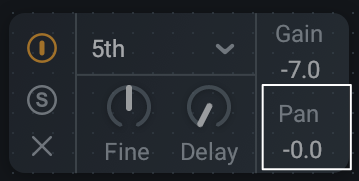
The Pan control allows for adjustments ranging from -100 (hard left) to +100 (hard right).
Voice Pan Adjustments
The Pan value of the selected voice node can be adjusted using the following methods:
- Click and drag the node left or right in the XY pad controller.
- Click on the Pan value readout in the voice controls panel and manually enter a value in the inline edit field.
Global Module Controls
The module chain features common controls for each module, including Bypass, Solo, Remove, Reorder, and Wet/Dry Mix.

Global Controls Chapter
To learn more about the module chain and other global controls in Nectar 3, visit the Global Controls chapter.
Pitch
Overview
Pitch correction can be used to fix out-of-tune vocal performances by automatically adjusting incoming notes to conform to the pitches of a specified musical scale. The Pitch module features controls for adjusting and tailoring pitch correction processing and a tuning meter to monitor incoming note values and the amount of pitch correction applied to each note.

Nectar 3 & Melodyne 4 essential
Melodyne 4 essential is included with Nectar 3. It can be used to edit the pitch and timing of individual notes within a vocal track.
Controls
The Vocal Register and Scale controls on the left side of the Pitch module panel are shared by the Pitch and Harmony modules.

These controls determine how the Pitch and Harmony modules detect pitch and apply correction to the incoming vocal.
Vocal Register
Determines how the Pitch and Harmony modules analyze and detect pitch data in the input signal.
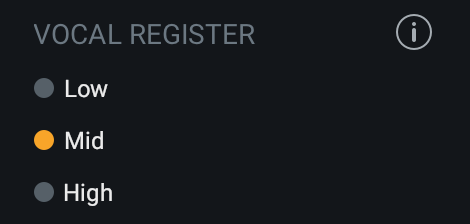
The Mid option will work well for a wide range of vocal material. If the pitch correction processing is producing artifacts or other undesirable behaviors, try using the Low or High settings to achieve better results.
Scale
Sets the type of scale used for pitch correction in the Pitch and Harmony modules. This setting determines the notes that the incoming vocal will be corrected to.

There are two scale type modes to choose from: Key or Custom. An Auto Detect feature is available in the PLUS edition of Nectar. Auto Detect can be used to help determine the scale of the incoming signal when Key mode is selected.
Calibrating Nectar's Reference Pitch
By default, pitch detection and correction assumes the input material was tuned to a standard A = 440Hz reference pitch. When working with material that was tuned to a different reference pitch, adjusting the Calibration Pitch value in the Options menu will improve the results of pitch detection and correction.
Key
When Key is selected, processing can be configured to correct an incoming vocal to notes included in the specified scale type/root note combination.
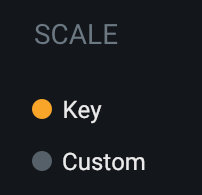
Root Note
Sets the root note or key for the selected scale type (Major or Minor only).
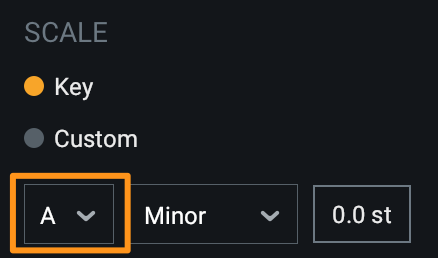
Note: No root note in Chromatic Scale
When Chromatic scale type is selected, the root note selection does not have an effect.
Scale Type
Sets the scale used to correct the incoming signal to.

You can choose from the following scale types when Key mode is selected:
- CHROMATIC: Any note in any octave will be used as a target pitch for correction.
- Root note does not have an effect when Chromatic is selected.
- When the key of the vocal is unknown, using the Chromatic scale type may offer the best results.
- Example: When Chromatic is selected, the following notes will be used as target pitches for correction: C, C#/Db, D, D#/Eb, E, F, F#/Gb, G, G#/Ab, A, A#/Bb, B
- MAJOR: Notes included in the selected Major key will be used as a target pitches for correction.
- Example: When C# Major is selected, the following notes will be used as target pitches for correction: C#, D#, E#, F#, G#, A#, B#
- MINOR: Notes included in the selected Minor key will be used as target pitches for correction.
- Example: When E Minor is selected, the following notes will be used as target pitches for correction: E, F#, G, A, B, C, D
Auto Detect
PLUS OnlyWhen Key mode is selected, the Auto Detect feature can be enabled to assist with selecting the root note and scale type of the incoming vocal.
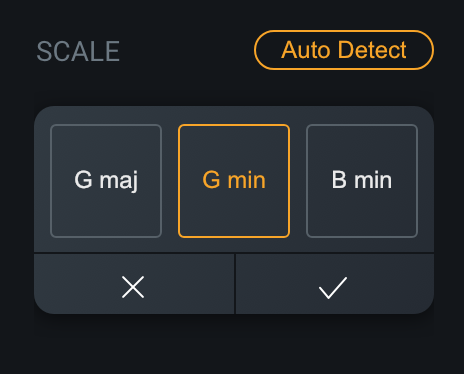
Click the Auto Detect button and playback audio to allow Nectar to begin listening to the incoming signal. As audio plays back, the three most likely scales will be displayed in the Auto Detect window.
Select the scale you would like to use and click the checkmark button to set the root note and scale type.
Click the x button to dismiss the Auto Detect window without changing the current scale settings.
Custom
When the Custom scale type is selected, a keyboard display will appear.
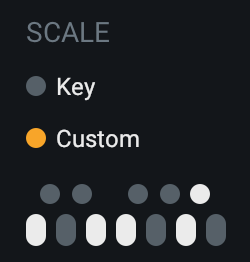
Clicking on individual keys will enable or disable them from the custom correction scale. When a key is disabled in this display, it will be excluded from the available target pitches when processing.
Transpose
Determines the static amount of pitch shift applied to the corrected vocal. This control allows for a transposition range of -12 semitones to +12 semitones and is set to 0 (no transposition) by default.

Note
Static transposition is only applied by the Pitch module. This processing does not affect the Harmony module.
Correction Controls
The following controls determine the character and speed of automatic pitch correction processing. These controls only apply to processing in the Pitch module.
Enable Correction
Enables or disables Pitch Correction processing.

Strength
Determines how strictly incoming signals will be corrected to notes in the selected scale.

Higher values will eliminate or reduce natural vibrato in the processed vocal. Lower values will retain vibrato in the processed vocal, allowing for more natural sounding results.
Speed
Determines how quickly incoming pitches will be corrected to notes in the selected scale.
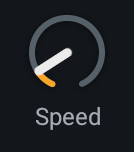
This control allows for a range of 0 milliseconds to 200 milliseconds. Lower speed settings equate to faster correction response, which can result in more robotic sounding pitch correction. Higher speed settings equate to slower correction response, which can result in more natural sounding pitch correction.
Formant
Enables or disables advanced controls for fine tuning formant shift and formant scaling.
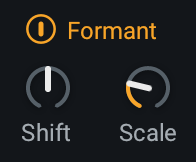
By default, Nectar preserves vocal formants in the incoming signal just as they were recorded. Formants contribute to the timbre of the human voice, an important aspect of a natural sounding vocal. In some cases, it may be necessary to adjust the formant shift and scaling parameters to achieve the best results.
Formant Shift
Determines the amount of formant transposition applied to the corrected vocal.

This control can be adjusted in increments of semitones (st). In general, the default value of 0 is suitable for most material.
Formant Scale
Determines the amount of scaling applied to formants when shifting pitch. Scale will always adjust formants in the direction of the pitch shift.

Increasing the amount of formant scaling will shift formants in the direction of the pitch shift. When a singer transitions to a higher note, their vocal formants will shift slightly higher in the direction of that note. Adjusting formant scaling can help to achieve more natural sounding results when a vocal is shifting up or down drastically between notes.
Global Module Controls
The module chain features common controls for each module, including Bypass, Solo, Remove, Reorder, and Wet/Dry Mix.

Pitch Module: Module Chain Behavior
- The Pitch module is always present in the first position of the module chain and cannot be moved or removed.
- However, if the correction controls are disabled in the Pitch module panel, pitch correction will not be applied to the output signal.
- The Mix slider in the Pitch module may introduce a doubling type of effect when set to a value that mixes wet and dry signals. For more information about the module chain, visit the Global Controls chapter.
Meters
When Correction controls are enabled, the tuner in the center of the module panel will become active.
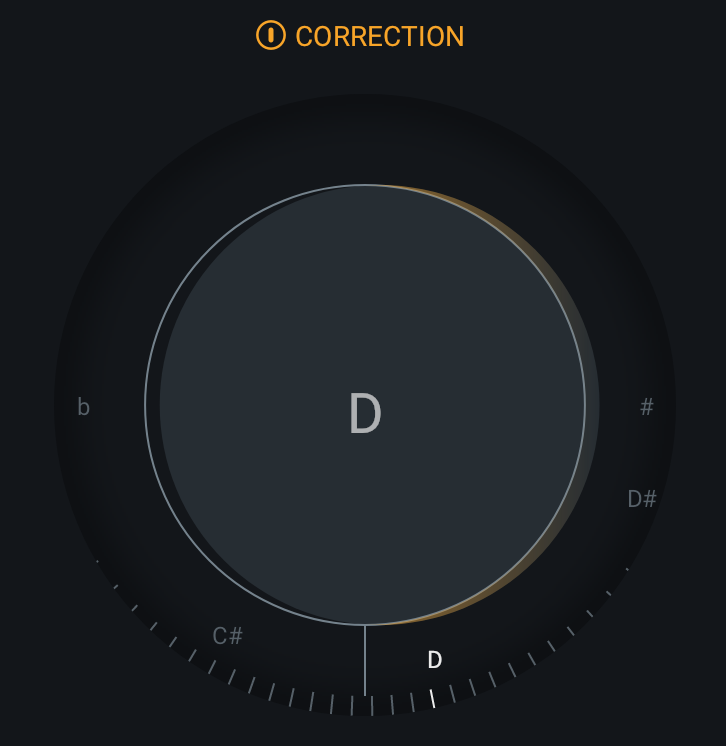
The tuner includes the following three components for monitoring the detected pitches and the effect of pitch correction processing:
Detected Input Pitch
The ruler shown at the bottom of the tuner updates to display the detected pitch of the incoming signal. The detected pitch value aligns with the vertical line that is centered directly above the ruler.

Target Pitch
The large circle in the center of the tuner displays the current target note for pitch correction. Only notes that are included in the selected Scale will be displayed here.
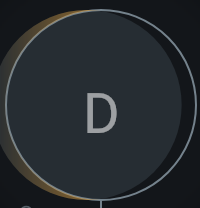
Correction Amount
When the detected input pitch and target pitch do not match, correction will be applied to the input signal. The yellow circle that moves to the left or right behind the target pitch display indicates if the detected pitch is flat or sharp relative to the target pitch.
The yellow circle will move to the right if the detected input pitch is sharp (higher than the target pitch). The signal will be pitched down to match the target pitch if it is detected to be sharp.
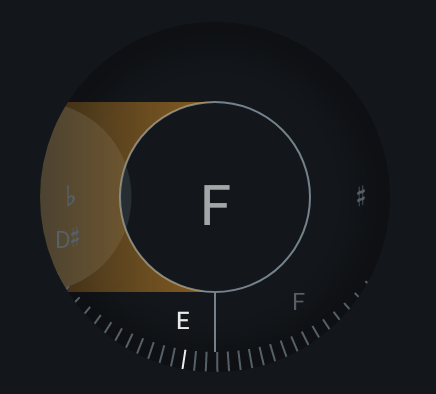
The yellow circle will move to the left if the detected input pitch is flat (lower than the target pitch). The signal will be pitched up to match the target pitch if it is detected to be flat.
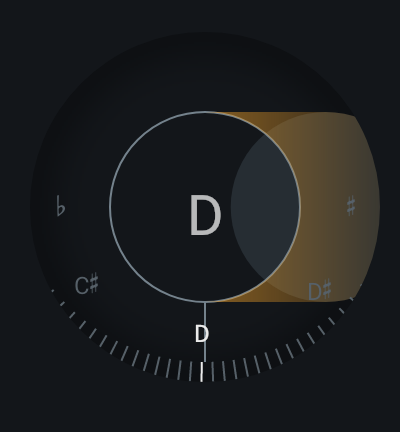
Reverb
Overview
Reverb can be used to add space and character to a vocal. The Nectar 3 Reverb module is modeled after the classic EMT 140ST Stereo Plate Reverb with added controls for adjusting Pre-delay and Width not included in the EMT 140ST hardware unit.

Controls
The Reverb module controls panel includes parameters for customizing the timing, width, and character of the reverb.

Pre-Delay
Determines the amount of time the processed (wet) signal is delayed from the output.
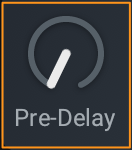
The Pre-Delay control ranges from 0ms (milliseconds) to 200ms (milliseconds).
Note
The EMT 140ST did not include a Pre-Delay control, it is included in the Nectar Reverb module for added control of the plate reverb sound. Pre-Delay is helpful for better clarity and separation between the wet and dry vocal signals.
Decay
Determines the amount of time it takes for reflections to dissipate.
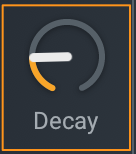
The Decay control ranges from 1.00s (seconds) to 5.00s (seconds).
Note
The Reverb module’s Decay time is not constant across all frequencies.
Width
Determines the amount of stereo widening applied to the output of the Reverb.

The Width control ranges from 0% (no stereo widening) to 100%.
Saturation
Determines the amount of subtle harmonic distortion added to the wet (processed) signal.

The Saturation control ranges from 0% (no saturation) to 100%.
Post Filter
The Reverb module features three customizable post filters. The Highpass and Lowpass filters can be used to reduce undesirable low frequency rumble or harsh high frequency content in the wet (processed) signal. The Bell filter can be used to add a creative or utilitarian boost or cut to the wet (processed) signal.

Post Filter
- The filters in the Reverb module are only applied to the wet (processed) output signal.
- Frequency Adjustments: Click and drag a filter node left and right to adjust frequency.
- Gain Adjustments: Click and drag a filter node up and down to adjust gain.
- The vertical ruler on the right side of the Reverb module panel display measures the gain of the Bell filter.
- Q (Bandwidth) Adjustments: Select a filter node and drag the handles that appear towards the node (narrow Q) or away from the node (wide Q).
NOTE: Gain and Q can only be adjusted for the Bell filter. The Highpass and Lowpass filters have fixed slope values.
Global Module Controls
The module chain features common controls for each module, including: Bypass, Solo, Remove, Reorder, and Mix.

Global Controls Chapter
To learn more about module chain and other global controls in Nectar 3, visit the Global Controls chapter.
Meters
The Reverb module features two spectrum analyzers for monitoring the effect of processing.
Spectrum Analyzer
Displays the magnitude (level, in dB) of a signal across the frequency spectrum in real-time. The vertical ruler on the left edge of the module panel measures the amplitude of the signal in decibels (dB). The horizontal ruler along the bottom edge of the module panel measures frequency in Hertz (Hz). The vertical ruler on the right edge of the module panel measures post-filter node gain (dB).

Two spectrum analyzers are displayed in the Reverb module: the input to the Reverb module (displayed in dark grey) and the output of the Reverb module (displayed in light grey).

Saturation
Overview
Saturation can be used to add subtle warmth or intense distortion to a vocal track. The Saturation module features seven different modes for accentuating harmonics and adding unique color and character to a vocal.

Controls
The following parameters are available in the Saturation module panel:
Mode
Determines the type of saturation applied to the signal.
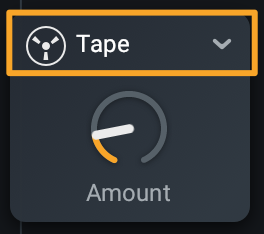
The following table outlines the sonic characteristics of the different saturation modes.
| Mode | Characteristics |
|---|---|
Analog 
|
Mild, gritty distortion. Transistor type emulation with emphasis on odd harmonics. |
Retro 
|
Sharp, aggressive distortion. Based on a row of odd harmonics that are characteristic of transistors. |
Tape 
|
Classic, analog tape saturation. Emphasizes odd harmonics but with a shorter harmonic slope than that of a transistor-type saturation. |
Tube 
|
Rich, tonal excitation. Emulates tube saturation with a mix of odd and even harmonics. |
Warm 
|
Subtle, harmonic warmth. Generates even harmonics with a steep slope. |
Decimate 
|
Unique, digital decimation. Reduces sample rate to introduce distortion artifacts introduced by aliasing. |
Distort 
|
Aggressive, dirty saturation. |
Amount
Determines the amount of drive applied to the selected saturation mode.
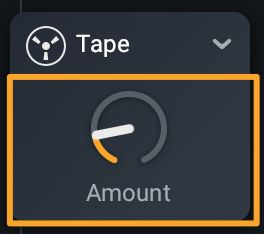
Post Filter
Allows for the reduction of undesirable high frequency content in the processed signal.
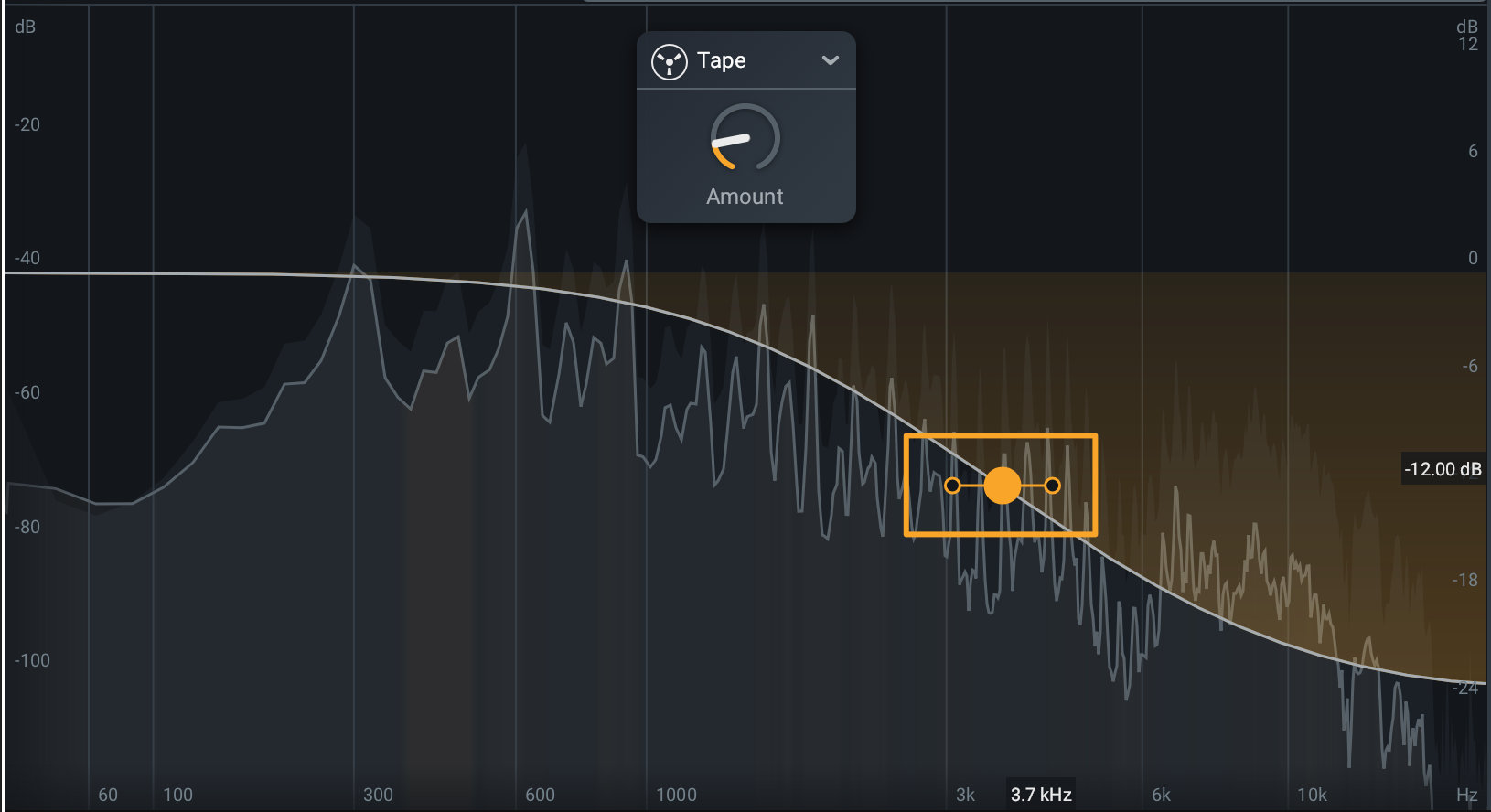
Post Filter Notes
- The high shelf filter in the Saturation module is only applied to the wet (processed) output of the module.
- Click and drag the filter node up and down to adjust gain.
- Click and drag the filter node left and right to adjust frequency.
Global Module Controls
The module chain features common controls for each module, including Bypass, Solo, Remove, Reorder, and Wet/Dry Mix.

Global Controls Chapter
To learn more about the module chain and other global controls in Nectar 3, visit the Global Controls chapter.
Meters
The Saturation module features two spectrum analyzers and a harmonic highlight display for monitoring the effect of processing.
Spectrum Analyzer
Displays the magnitude (level) of a signal across the frequency spectrum in real-time. The vertical ruler on the left edge of the module panel measures the amplitude of the signal in decibels (dB). The horizontal ruler along the bottom edge of the module panel measures frequency in Hertz (Hz).

Two spectrum analyzers are displayed in the Saturation module: the input to the Saturation module (displayed in dark grey) and the output of the Saturation module (displayed in light grey).

Harmonic Highlights
The harmonic content that is generated and added by the Saturation module is represented by the yellow fill color that appears when playing back audio.

Global Controls
Overview
The Module Chain and I/O section include a number of parameters for customizing the IPC instance name, signal flow, levels, and stereo image of Nectar 3.
Resizable Window
Nectar 3 features a resizable main window. The window can be resized by clicking and dragging the bottom right corner of the plug-in window.
Plug-in Instance Name
Determines the name of the current instance when it appears in IPC lists in supported iZotope plug-ins.

Module Chain
The Module Chain allows for highly customizable vocal processing chains.

The following modules can be added to the module chain:
- Compressor (x2)
- De-esser
- Delay
- Dimension
- EQ (x2)
- Gate
- Harmony
- Pitch
- Reverb
- Saturation
The following functions and controls are available in the module chain:
Add
Clicking the + button in the rightmost position of the module chain will open the module menu. Select a module from the list to add it to the last slot in the module chain.
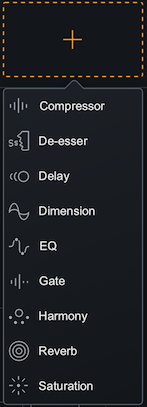
Module Limits
Most modules can only be added to the module chain once. If a module has been added to the module chain already, the option in the module list will be greyed out. Only the EQ and Compressor modules can be added to the module chain twice.
Reorder
Click and drag a module panel left or right within the Module Chain to change its order in the signal flow.
Pitch Module
The Pitch module is always present in the first position of the Module Chain. It cannot be removed or reordered. See the Pitch chapter for more information about the Pitch module.
Enable
Click the power button the upper left corner of a module tile to bypass processing of that module.
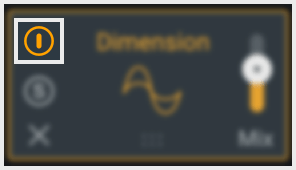
Solo
Click the S button on the left side of a module tile to bypass processing in all other modules.
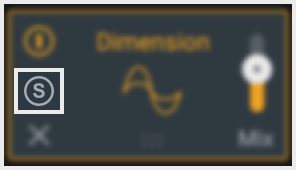
Remove
Click the X button on the left side of a module tile to remove the associated module from the module chain.
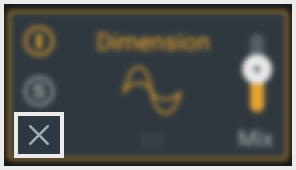
Mix
The slider on the right side of a module tile adjusts the balance between the dry (unprocessed) and wet (processed) signals.
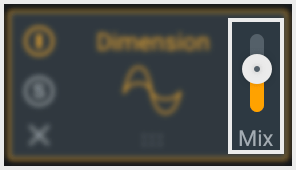
ALM (Auto Level Mode)
The ALM button above the input level meter enables or disables ALM (Auto Level Mode) processing.
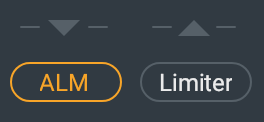
When enabled, ALM will adjust input gain in order to hit the ALM target level. ALM looks at the RMS level of the input signal, when that level is within 3dB (above or below) of the target level, it will dynamically adjust the input gain up or down in order to match the it to the target level.
ALM will only ever add or subtract 3dB of gain from the input, so if the RMS level of the input is 3 dB or more below the target, it will add 3dB of gain to the input. If the RMS input level is 3dB more above the target, it will lower the gain of the input by 3dB.
Input Level Meter
When ALM is enabled, The input level meter will display the input signal after ALM processing has been applied to the input signal.
ALM Target Level
Adjusts the ALM target level when ALM is enabled.
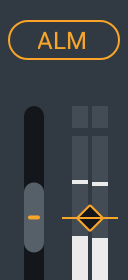
Tips: Adjusting ALM Target
The ALM Target Level can be adjusted using the following methods:
- Click and drag the slider handle up (increase target level) or down (decrease target level).
- Click on the slider handle and then click on the text readout display that appears. Manually enter an ALM Target in the inline edit field.
Limiter
Enables a brickwall, zero latency limiter on the output signal. The Limiter is applied to the signal after output gain.
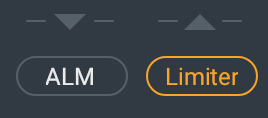
Ceiling
Determines the maximum output level of the plug-in when the limiter is enabled.
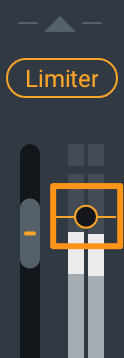
The hard limiter uses the Ceiling as an absolute guide, and the final output level will not exceed this point.
Tips: Adjusting the Limiter Ceiling
The Limiter Ceiling can be adjusted using the following methods:
- Click and drag the slider handle up (increase ceiling level) or down (decrease ceiling level).
- Click on the slider handle and then click on the text readout display that appears. Manually enter a Ceiling value in the inline edit field.
Gain Reduction Meter
Displays the amount of gain reduction applied to the output signal by the Limiter.

Input and Output
Meters
The Input and Output meters display Peak and RMS metering information. The Peak level meter is displayed in white. The RMS level meter is displayed in grey.
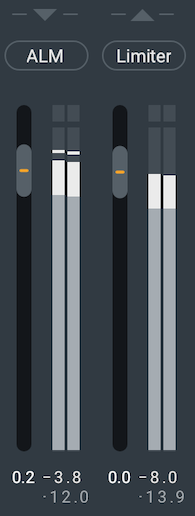
The text readouts directly below the meters display the current Peak and RMS values. The current Peak value is displayed in white. The current RMS value is displayed in light grey.

Gain
The Input and Output Gain can be adjusted using the sliders to the left of the input and output meters.
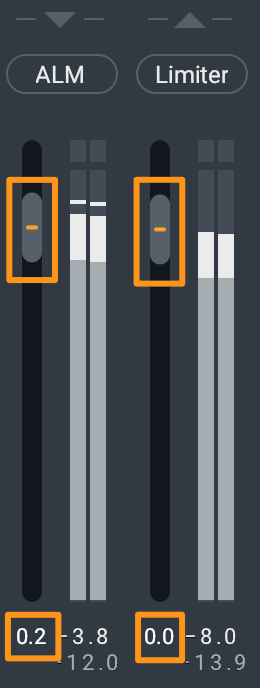
Tips: Adjusting the I/O Gain
The Input and Output Gain can be adjusted using the following methods:
- Click and drag the slider handle up (increase input or output gain) or down (decrease input or output gain).
- Double-click on the text readout directly below the gain sliders and manually enter a gain value in the inline edit field.
Bypass
Bypasses all processing applied by Nectar 3.
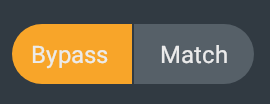
Match
When Nectar 3 is bypassed and Match is enabled, the bypassed signal level will be adjusted to match the processed output level.

Width
Adjusts the amount of stereo widening. Decreasing this control results in a narrowing effect (-100% is equivalent to mono), increasing this control widens the apparent stereo field.
Stereo Instances Only
Width is only functional in stereo instances of Nectar.

Pan
Pans the output signal to the left or right channel.
Stereo Instances Only
Pan is only functional in stereo instances of Nectar.

Presets
Overview
Choose from a wide variety of factory presets and save your own custom vocal processing chains in the Nectar Presets window. You can open the preset manager by clicking the button labeled Presets in the header area of Nectar.

Tip
You can quickly cycle through presets in the preset list by clicking the previous or next buttons to the right of the Presets button.
You can load, save, and manage presets in the Nectar Presets window. You can load the settings associated with a preset by selecting it from the list.

The Presets window is divided into two tabs:
- iZotope: lists all factory presets installed with Nectar 3.
- Custom: lists all custom presets you have saved or modified in Nectar 3.
There are two global options that appear in the iZotope and Custom tabs at the top of the preset list:
- Working Settings: Loads your most recent changes that are not otherwise associated with a preset.
- Default: Loads the factory default settings.
Dirty state indicator
When you make changes to a preset an asterisk (*) will be shown at the beginning of the preset name to indicate that it has been modified. You can add a new preset to save your settings or update the preset to dismiss the dirty state indicator.
Modify Custom Preset Names and Comments
You can modify preset file/folder names and preset comments when the Custom tab is selected.
- Edit custom preset name: Single-click twice on a preset name in the Custom tab to open an inline edit field. Press return to dismiss the inline edit field and save your changes.
- Edit custom preset comment: The area below the preset list displays descriptive text about the currently selected preset. Single-click the comment text box to open an inline edit field, press return to save changes to the comment.
Presets Window Controls
The following buttons are located in the footer of the Presets window:

- Deletes the currently selected custom preset or preset folder.
- Update: Saves changes to a modified custom preset.
- Folder: Adds a new custom preset folder.
- New: Creates a new preset based on the current settings.
- Close: Dismiss the Presets window. Note: Double-clicking on a preset or preset folder will also close the Presets window.
Organize Custom Presets
In the Custom tab, you can click and drag presets or folders over other folders in the list to move them into that folder.
Preset Locations
Factory presets are installed to the following locations:
- Windows:
C:\Program Files\iZotope\Nectar 3\Presets\ - Mac:
/Library/Application Support/iZotope/Nectar 3/Presets/
Custom presets are saved to the following locations:
- Windows:
C:\Users\Username\iZotope\Nectar 3\Presets\ - Mac:
/Users/Username/Documents/iZotope/Nectar 3/Presets/
Options
Overview
The Options window includes parameters for managing authorization, updates, and module specific controls. The Options window can be opened by clicking on the gear button in the upper right corner of the Nectar 3 interface.
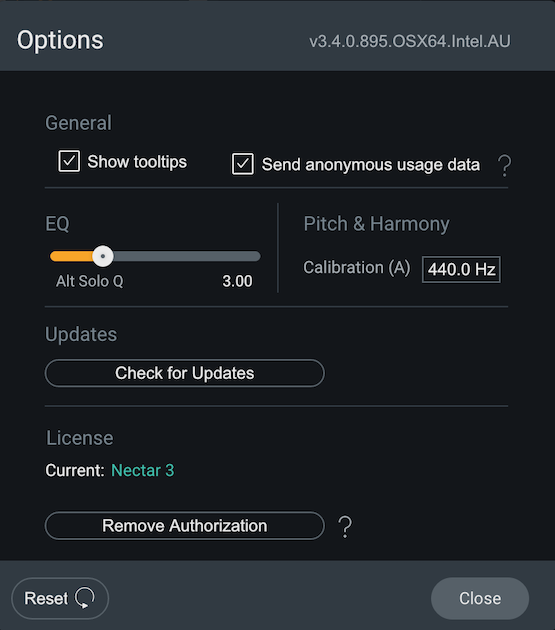
The following categories are available in the Nectar 3 Options window:
General
- Show tooltips: Enables or disables the tooltip display text.
- Send anonymous usage data: Enables sending anonymous usage data to iZotope to help improve Nectar 3.
EQ
Alt Solo Q: Sets the default bandwidth of the Alt-Solo Feature. The default is 5.02.
EQ: Alt-Solo
See the EQ chapter for more information about the Alt-Solo feature.
Pitch and Harmony
Calibration (A): sets the audio frequency reference to calibrate the Vocal Register and Scale in the Pitch Module. The default is 440 Hz.
Pitch: Reference Pitch Calibration
See the Pitch chapter for more information about Pitch Correction.
Updates
- Download Product Portal: To stay up to date with new versions of Nectar 3, download the iZotope Product Portal application.
- Check for Updates: Manually check for available updates. Clicking this button will open the Product Portal application and check for updates.
- Download Update: If an update is available, a small yellow dot will appear. Clicking the Download Update button in the options window will launch the Product Portal application and display the Updates page.
Licenses
This section allows you to view your current license status, manage your license, and access more information about licensing the product.
Additional help with licensing and installation
Visit the iZotope Support website for additional information about licensing, authorization and installation.
support.izotope.com/hc/en-us/sections/360004410134
Apply Changes
To apply changes and close the Options window, click anywhere within the Nectar 3 interface and outside of the Options window.
Important: Any changes made to the Options window will be applied once the window is closed. You cannot cancel changes made, but you can reset to the factory default.
Reset
Press the Reset Button in the lower left-hand corner of the Global Options Window to reset any changes made within the Global Options window to the default setting.
Tip
The Reset button in the Options window will reset Nectar 3 plug-in window size to the factory default window size.
Authorization
Overview
The first time you open Nectar 3, the Authorization window will appear.
The Authorization window allows you to:
- TRIAL: Start or continue a Trial period evaluation prior to purchasing.
- DEMO: Continue evaluating the product with Demo limitations (after the 10 day Trial period has been exceeded).
- AUTHORIZE: Authorize the product with a serial number.
Trial and Demo Modes
A 10 day trial period will start when you first open the Nectar 3 plug-in. After the 10 day trial period has expired, Nectar 3 will enter demo mode. To disable Trial or Demo mode, you must authorize the product with a valid serial number.
Trial Mode
Trial mode begins when Nectar 3 is first instantiated in a DAW/NLE. The authorization wizard window will display the number of days remaining in your trial period.
Clicking on the “Continue” button will dismiss the Authorization window and allow you to continue evaluating Nectar 3 in trial mode.
Demo Mode
After 10 days, Nectar 3 will operate in Demo mode. Nectar 3 will periodically output silence when operating in demo mode. If you would like to continue evaluating Nectar 3 in demo mode, click the “Demo” button.
Authorizing Nectar 3
There are three methods for authorizing Nectar 3:
- Online Authorization: Use this method to authorize Nectar 3 on a machine that is connected to the internet.
- Offline Authorization: Use this method to authorize Nectar 3 on a machine that is not connected to the internet.
- iLok Authorization: Use this method to authorize Nectar 3 using an iLok.
More Information
For information on authorization, please visit the iZotope website: How to authorize iZotope software
For additional help with authorizing Nectar 3:
- Check out the Customer Care pages on the iZotope website: support.izotope.com/hc/en-us
- Contact our Customer Care department at support@izotope.com
- More information on iZotope’s Customer Care department and policies can be found in the Customer Care chapter.
Customer Care
Purchasing Nectar 3
If you are using the demo version of Nectar 3 and would like the full version, you can purchase Nectar 3 direct from the iZotope online store: www.izotope.com/en/shop.html
Once your purchase is complete, you will be sent an email confirmation and a full version serial number that can be used to fully authorize your current installation of Nectar 3.
iZotope Customer Care policy
iZotope is happy to provide professional technical Customer Care to all registered users absolutely free of charge. support.izotope.com
We also offer valuable pre-sales technical Customer Care to customers who may be interested in purchasing an iZotope product. Before contacting iZotope Customer Care, you can search our Product Knowledgebase to see if the solution to your problem has already been published.
How long does iZotope provide customer support for purchased products? You can email us with any question for 12 months after you buy any iZotope product. Past 12 months, we’ll still help you with your account and authorization but will not provide technical support for in-depth product questions. If you need more detailed help on how to use the product, please check out our FAQs and Tutorials.
How long does iZotope support its products? Although we can’t guarantee it, we do our best to keep our products up to date with the operating systems and plug-in hosts that we support. Sometimes, other companies make changes that we’re not able to support, but we actively work with other companies to avoid these sorts of compatibility problems. We also do our best to address bug fixes within the product itself to ensure our products operate in accordance with our specifications.
We will provide software updates for 12 months from product release. After 12 months, no software updates will be provided.
For details on what operating systems and plug-in host software are officially supported for a product, please check that product’s Specs page.
Contacting iZotope Customer Care
For additional help with Nectar 3:
- Check out the Customer Care pages on our web site at support.izotope.com
- Contact our Customer Care department at support@izotope.com
iZotope’s highly trained Customer Care team is committed to responding to all requests within one (1) business day and frequently respond faster. Please try to explain your problem with as much detail and clarity as possible. This will ensure our ability to solve your problem accurately, the first time around. Please include all system specs and the build/version of Nectar 3 that you are using.
Once your Customer Care request is submitted, you will receive a confirmation email from iZotope Customer Care. If you do not receive this email within a few minutes, please check your spam folder and make sure our responses are not getting blocked. To prevent this from happening please add support@izotope.com to your list of allowed email addresses.
International distribution
Customer Care is also available from our international distributors worldwide for any customers who purchased their iZotope products through a certified iZotope distributor.
Check with your local distributor for availability. If you would like help locating your local distributor please contact iZotope Customer Care.
Thanks for using Nectar 3!
-The iZotope Team
License Information
Table of Contents
- Anti-Grain Geometry
- Better Enums
- Bravura
- C++ Rest SDK
- Eigen
- FLAC
- FreeType
- GLEW
- gsl
- IcoMoon
- Intel® Integrated Performance Primitives (Intel® IPP)
- JsonCpp
- LibXML2
- Material Docs Theme
- nanomsg
- Netlib numeralgo na10 Aberth’s method
- OGG / Vorbis
- readerwriterqueue
- Roboto font family
- Skia
- TagLib
- TinyXML
- Tipue Search
- vectorize
- xsimd
- Yoga
- ZeroMQ
- zlib
Anti-Grain Geometry
Version 2.4
Copyright (c) 2002-2005 Maxim Shemanarev (McSeem).
Redistribution and use in source and binary forms, with or without modification, are permitted provided that the following conditions are met:
-
Redistributions of source code must retain the above copyright notice, this list of conditions and the following disclaimer.
-
Redistributions in binary form must reproduce the above copyright notice, this list of conditions and the following disclaimer in the documentation and/or other materials provided with the distribution.
-
The name of the author may not be used to endorse or promote products derived from this software without specific prior written permission.
THIS SOFTWARE IS PROVIDED BY THE AUTHOR ‘‘AS IS’’ AND ANY EXPRESS OR IMPLIED WARRANTIES, INCLUDING, BUT NOT LIMITED TO, THE IMPLIED WARRANTIES OF MERCHANTABILITY AND FITNESS FOR A PARTICULAR PURPOSE ARE DISCLAIMED. IN NO EVENT SHALL THE AUTHOR BE LIABLE FOR ANY DIRECT, INDIRECT, INCIDENTAL, SPECIAL, EXEMPLARY, OR CONSEQUENTIAL DAMAGES (INCLUDING, BUT NOT LIMITED TO, PROCUREMENT OF SUBSTITUTE GOODS OR SERVICES; LOSS OF USE, DATA, OR PROFITS; OR BUSINESS INTERRUPTION) HOWEVER CAUSED AND ON ANY THEORY OF LIABILITY, WHETHER IN CONTRACT, STRICT LIABILITY, OR TORT (INCLUDING NEGLIGENCE OR OTHERWISE) ARISING IN ANY WAY OUT OF THE USE OF THIS SOFTWARE, EVEN IF ADVISED OF THE POSSIBILITY OF SUCH DAMAGE.
Better Enums
Version 0.11.1
Copyright (c) 2012-2016, Anton Bachin. All rights reserved.
Redistribution and use in source and binary forms, with or without modification, are permitted provided that the following conditions are met:
-
Redistributions of source code must retain the above copyright notice, this list of conditions and the following disclaimer.
-
Redistributions in binary form must reproduce the above copyright notice, this list of conditions and the following disclaimer in the documentation and/or other materials provided with the distribution.
THIS SOFTWARE IS PROVIDED BY THE COPYRIGHT HOLDERS AND CONTRIBUTORS “AS IS” AND ANY EXPRESS OR IMPLIED WARRANTIES, INCLUDING, BUT NOT LIMITED TO, THE IMPLIED WARRANTIES OF MERCHANTABILITY AND FITNESS FOR A PARTICULAR PURPOSE ARE DISCLAIMED. IN NO EVENT SHALL THE COPYRIGHT HOLDER OR CONTRIBUTORS BE LIABLE FOR ANY DIRECT, INDIRECT, INCIDENTAL, SPECIAL, EXEMPLARY, OR CONSEQUENTIAL DAMAGES (INCLUDING, BUT NOT LIMITED TO, PROCUREMENT OF SUBSTITUTE GOODS OR SERVICES; LOSS OF USE, DATA, OR PROFITS; OR BUSINESS INTERRUPTION) HOWEVER CAUSED AND ON ANY THEORY OF LIABILITY, WHETHER IN CONTRACT, STRICT LIABILITY, OR TORT (INCLUDING NEGLIGENCE OR OTHERWISE) ARISING IN ANY WAY OUT OF THE USE OF THIS SOFTWARE, EVEN IF ADVISED OF THE POSSIBILITY OF SUCH DAMAGE.
Bravura
Copyright (c) 2015, Steinberg Media Technologies GmbH http://www.steinberg.net/, with Reserved Font Name “Bravura”.
This Font Software is licensed under the SIL Open Font License, Version 1.1. This license is copied below, and is also available with a FAQ at: http://scripts.sil.org/OFL
SIL OPEN FONT LICENSE Version 1.1 - 26 February 2007
PREAMBLE
The goals of the Open Font License (OFL) are to stimulate worldwide development of collaborative font
projects, to support the font creation efforts of academic and linguistic communities, and to provide a free
and open framework in which fonts may be shared and improved in partnership with others.
The OFL allows the licensed fonts to be used, studied, modified and redistributed freely as long as they are not sold by themselves. The fonts, including any derivative works, can be bundled, embedded, redistributed and/or sold with any software provided that any reserved names are not used by derivative works. The fonts and derivatives, however, cannot be released under any other type of license. The requirement for fonts to remain under this license does not apply to any document created using the fonts or their derivatives.
DEFINITIONS
“Font Software” refers to the set of files released by the Copyright Holder(s) under this license and clearly
marked as such. This may include source files, build scripts and documentation.
“Reserved Font Name” refers to any names specified as such after the copyright statement(s).
“Original Version” refers to the collection of Font Software components as distributed by the Copyright Holder(s).
“Modified Version” refers to any derivative made by adding to, deleting, or substituting – in part or in whole – any of the components of the Original Version, by changing formats or by porting the Font Software to a new environment.
“Author” refers to any designer, engineer, programmer, technical writer or other person who contributed to the Font Software.
PERMISSION & CONDITIONS
Permission is hereby granted, free of charge, to any person obtaining a copy of the Font Software, to use,
study, copy, merge, embed, modify, redistribute, and sell modified and unmodified copies of the Font Software,
subject to the following conditions:
-
Neither the Font Software nor any of its individual components, in Original or Modified Versions, may be sold by itself.
-
Original or Modified Versions of the Font Software may be bundled, redistributed and/or sold with any software, provided that each copy contains the above copyright notice and this license. These can be included either as stand-alone text files, human-readable headers or in the appropriate machine-readable metadata fields within text or binary files as long as those fields can be easily viewed by the user.
-
No Modified Version of the Font Software may use the Reserved Font Name(s) unless explicit written permission is granted by the corresponding Copyright Holder. This restriction only applies to the primary font name as presented to the users.
-
The name(s) of the Copyright Holder(s) or the Author(s) of the Font Software shall not be used to promote, endorse or advertise any Modified Version, except to acknowledge the contribution(s) of the Copyright Holder(s) and the Author(s) or with their explicit written permission.
-
The Font Software, modified or unmodified, in part or in whole, must be distributed entirely under this license, and must not be distributed under any other license. The requirement for fonts to remain under this license does not apply to any document created using the Font Software.
TERMINATION
This license becomes null and void if any of the above conditions are not met.
DISCLAIMER
THE FONT SOFTWARE IS PROVIDED “AS IS”, WITHOUT WARRANTY OF ANY KIND, EXPRESS OR IMPLIED, INCLUDING BUT NOT
LIMITED TO ANY WARRANTIES OF MERCHANTABILITY, FITNESS FOR A PARTICULAR PURPOSE AND NONINFRINGEMENT OF
COPYRIGHT, PATENT, TRADEMARK, OR OTHER RIGHT. IN NO EVENT SHALL THE COPYRIGHT HOLDER BE LIABLE FOR ANY CLAIM,
DAMAGES OR OTHER LIABILITY, INCLUDING ANY GENERAL, SPECIAL, INDIRECT, INCIDENTAL, OR CONSEQUENTIAL DAMAGES,
WHETHER IN AN ACTION OF CONTRACT, TORT OR OTHERWISE, ARISING FROM, OUT OF THE USE OR INABILITY TO USE THE FONT
SOFTWARE OR FROM OTHER DEALINGS IN THE FONT SOFTWARE.
C++ Rest SDK
Version 2.10.15
Main Library:
Copyright (c) 2014, Peter Thorson. All rights reserved.
Redistribution and use in source and binary forms, with or without modification, are permitted provided that the following conditions are met:
-
Redistributions of source code must retain the above copyright notice, this list of conditions and the following disclaimer.
-
Redistributions in binary form must reproduce the above copyright notice, this list of conditions and the following disclaimer in the documentation and/or other materials provided with the distribution.
-
Neither the name of the WebSocket++ Project nor the names of its contributors may be used to endorse or promote products derived from this software without specific prior written permission.
THIS SOFTWARE IS PROVIDED BY THE COPYRIGHT HOLDERS AND CONTRIBUTORS “AS IS” AND ANY EXPRESS OR IMPLIED WARRANTIES, INCLUDING, BUT NOT LIMITED TO, THE IMPLIED WARRANTIES OF MERCHANTABILITY AND FITNESS FOR A PARTICULAR PURPOSE ARE DISCLAIMED. IN NO EVENT SHALL PETER THORSON BE LIABLE FOR ANY DIRECT, INDIRECT, INCIDENTAL, SPECIAL, EXEMPLARY, OR CONSEQUENTIAL DAMAGES (INCLUDING, BUT NOT LIMITED TO, PROCUREMENT OF SUBSTITUTE GOODS OR SERVICES; LOSS OF USE, DATA, OR PROFITS; OR BUSINESS INTERRUPTION) HOWEVER CAUSED AND ON ANY THEORY OF LIABILITY, WHETHER IN CONTRACT, STRICT LIABILITY, OR TORT (INCLUDING NEGLIGENCE OR OTHERWISE) ARISING IN ANY WAY OUT OF THE USE OF THIS SOFTWARE, EVEN IF ADVISED OF THE POSSIBILITY OF SUCH DAMAGE.
Bundled Libraries:
****** Base 64 Library (base64/base64.hpp) ******
base64.hpp is a repackaging of the base64.cpp and base64.h files into a single header suitable for use as a
header only library. This conversion was done by Peter Thorson (webmaster@zaphoyd.com) in 2012. All
modifications to the code are redistributed under the same license as the original, which is listed below.
base64.cpp and base64.h
Copyright (C) 2004-2008 René Nyffenegger
This source code is provided ‘as-is’, without any express or implied warranty. In no event will the author be held liable for any damages arising from the use of this software.
Permission is granted to anyone to use this software for any purpose, including commercial applications, and to alter it and redistribute it freely, subject to the following restrictions:
-
The origin of this source code must not be misrepresented; you must not claim that you wrote the original source code. If you use this source code in a product, an acknowledgment in the product documentation would be appreciated but is not required.
-
Altered source versions must be plainly marked as such, and must not be misrepresented as being the original source code.
-
This notice may not be removed or altered from any source distribution.
René Nyffenegger rene.nyffenegger@adp-gmbh.ch
****** SHA1 Library (sha1/sha1.hpp) ******
sha1.hpp is a repackaging of the sha1.cpp and sha1.h files from the shallsha1 library (http://code.google.com/p/smallsha1/) into a single header suitable for use as a header only library. This conversion was done by Peter Thorson (webmaster@zaphoyd.com) in 2013. All modifications to the code are redistributed under the same license as the original, which is listed below.
Copyright (c) 2011, Micael Hildenborg
All rights reserved.
Redistribution and use in source and binary forms, with or without modification, are permitted provided that the following conditions are met:
- Redistributions of source code must retain the above copyright notice, this list of conditions and the following disclaimer.
- Redistributions in binary form must reproduce the above copyright notice, this list of conditions and the following disclaimer in the documentation and/or other materials provided with the distribution.
- Neither the name of Micael Hildenborg nor the names of its contributors may be used to endorse or promote products derived from this software without specific prior written permission.
THIS SOFTWARE IS PROVIDED BY Micael Hildenborg ‘‘AS IS’’ AND ANY EXPRESS OR IMPLIED WARRANTIES, INCLUDING, BUT NOT LIMITED TO, THE IMPLIED WARRANTIES OF MERCHANTABILITY AND FITNESS FOR A PARTICULAR PURPOSE ARE DISCLAIMED. IN NO EVENT SHALL Micael Hildenborg BE LIABLE FOR ANY DIRECT, INDIRECT, INCIDENTAL, SPECIAL, EXEMPLARY, OR CONSEQUENTIAL DAMAGES (INCLUDING, BUT NOT LIMITED TO, PROCUREMENT OF SUBSTITUTE GOODS OR SERVICES; LOSS OF USE, DATA, OR PROFITS; OR BUSINESS INTERRUPTION) HOWEVER CAUSED AND ON ANY THEORY OF LIABILITY, WHETHER IN CONTRACT, STRICT LIABILITY, OR TORT (INCLUDING NEGLIGENCE OR OTHERWISE) ARISING IN ANY WAY OUT OF THE USE OF THIS SOFTWARE, EVEN IF ADVISED OF THE POSSIBILITY OF SUCH DAMAGE.
****** MD5 Library (common/md5.hpp) ******
md5.hpp is a reformulation of the md5.h and md5.c code from
http://www.opensource.apple.com/source/cups/cups-59/cups/md5.c to allow it to function as a component of a
header only library. This conversion was done by Peter Thorson (webmaster@zaphoyd.com) in 2012 for the
WebSocket++ project. The changes are released under the same license as the original (listed below)
Copyright (C) 1999, 2002 Aladdin Enterprises. All rights reserved.
This software is provided ‘as-is’, without any express or implied warranty. In no event will the authors be held liable for any damages arising from the use of this software.
Permission is granted to anyone to use this software for any purpose, including commercial applications, and to alter it and redistribute it freely, subject to the following restrictions:
- The origin of this software must not be misrepresented; you must not claim that you wrote the original software. If you use this software in a product, an acknowledgment in the product documentation would be appreciated but is not required.
- Altered source versions must be plainly marked as such, and must not be misrepresented as being the original software.
- This notice may not be removed or altered from any source distribution.
L. Peter Deutsch
ghost@aladdin.com
****** UTF8 Validation logic (utf8_validation.hpp) ******
utf8_validation.hpp is adapted from code originally written by Bjoern Hoehrmann bjoern@hoehrmann.de. See
http://bjoern.hoehrmann.de/utf-8/decoder/dfa/ for details.
The original license:
Copyright (c) 2008-2009 Bjoern Hoehrmann bjoern@hoehrmann.de
Permission is hereby granted, free of charge, to any person obtaining a copy of this software and associated documentation files (the “Software”), to deal in the Software without restriction, including without limitation the rights to use, copy, modify, merge, publish, distribute, sublicense, and/or sell copies of the Software, and to permit persons to whom the Software is furnished to do so, subject to the following conditions:
The above copyright notice and this permission notice shall be included in all copies or substantial portions of the Software.
THE SOFTWARE IS PROVIDED “AS IS”, WITHOUT WARRANTY OF ANY KIND, EXPRESS OR IMPLIED, INCLUDING BUT NOT LIMITED TO THE WARRANTIES OF MERCHANTABILITY, FITNESS FOR A PARTICULAR PURPOSE AND NONINFRINGEMENT. IN NO EVENT SHALL THE AUTHORS OR COPYRIGHT HOLDERS BE LIABLE FOR ANY CLAIM, DAMAGES OR OTHER LIABILITY, WHETHER IN AN ACTION OF CONTRACT, TORT OR OTHERWISE, ARISING FROM, OUT OF OR IN CONNECTION WITH THE SOFTWARE OR THE USE OR OTHER DEALINGS IN THE SOFTWARE.
Eigen
Version 3.4.99
Distributed under the Mozilla Public License v2.0 (MPLv2.0).
Full text of the license is available here: https://www.mozilla.org/en-US/MPL/2.0/
To receive a copy of the source code for the Eigen library distributed with this product under the terms of the MPLv2.0 please contact devsupport@izotope.com.
FLAC
libFLAC and libFLAC++
Version 1.3.2
Copyright (c) 2000-2009 Josh Coalson
Copyright (c) 2011-2016 Xiph.Org Foundation
Redistribution and use in source and binary forms, with or without modification, are permitted provided that the following conditions are met:
-
Redistributions of source code must retain the above copyright notice, this list of conditions and the following disclaimer.
-
Redistributions in binary form must reproduce the above copyright notice, this list of conditions and the following disclaimer in the documentation and/or other materials provided with the distribution.
-
Neither the name of the Xiph.org Foundation nor the names of its contributors may be used to endorse or promote products derived from this software without specific prior written permission.
THIS SOFTWARE IS PROVIDED BY THE COPYRIGHT HOLDERS AND CONTRIBUTORS “AS IS” AND ANY EXPRESS OR IMPLIED WARRANTIES, INCLUDING, BUT NOT LIMITED TO, THE IMPLIED WARRANTIES OF MERCHANTABILITY AND FITNESS FOR A PARTICULAR PURPOSE ARE DISCLAIMED. IN NO EVENT SHALL THE FOUNDATION OR CONTRIBUTORS BE LIABLE FOR ANY DIRECT, INDIRECT, INCIDENTAL, SPECIAL, EXEMPLARY, OR CONSEQUENTIAL DAMAGES (INCLUDING, BUT NOT LIMITED TO, PROCUREMENT OF SUBSTITUTE GOODS OR SERVICES; LOSS OF USE, DATA, OR PROFITS; OR BUSINESS INTERRUPTION) HOWEVER CAUSED AND ON ANY THEORY OF LIABILITY, WHETHER IN CONTRACT, STRICT LIABILITY, OR TORT (INCLUDING NEGLIGENCE OR OTHERWISE) ARISING IN ANY WAY OUT OF THE USE OF THIS SOFTWARE, EVEN IF ADVISED OF THE POSSIBILITY OF SUCH DAMAGE.
FreeType
Version 2.4.6
Portions of this software are copyright © 2011 The FreeType Project (www.freetype.org). All rights reserved.
GLEW
The OpenGL Extension Wrangler Library
Copyright (C) 2002-2008, Milan Ikits <milan ikits[]ieee org>
Copyright (C) 2002-2008, Marcelo E. Magallon <mmagallo[]debian org>
Copyright (C) 2002, Lev Povalahev
All rights reserved.
Redistribution and use in source and binary forms, with or without modification, are permitted provided that the following conditions are met:
-
Redistributions of source code must retain the above copyright notice, this list of conditions and the following disclaimer.
-
Redistributions in binary form must reproduce the above copyright notice, this list of conditions and the following disclaimer in the documentation and/or other materials provided with the distribution.
-
The name of the author may be used to endorse or promote products derived from this software without specific prior written permission.
THIS SOFTWARE IS PROVIDED BY THE COPYRIGHT HOLDERS AND CONTRIBUTORS “AS IS” AND ANY EXPRESS OR IMPLIED WARRANTIES, INCLUDING, BUT NOT LIMITED TO, THE IMPLIED WARRANTIES OF MERCHANTABILITY AND FITNESS FOR A PARTICULAR PURPOSE ARE DISCLAIMED. IN NO EVENT SHALL THE COPYRIGHT OWNER OR CONTRIBUTORS BE LIABLE FOR ANY DIRECT, INDIRECT, INCIDENTAL, SPECIAL, EXEMPLARY, OR CONSEQUENTIAL DAMAGES (INCLUDING, BUT NOT LIMITED TO, PROCUREMENT OF SUBSTITUTE GOODS OR SERVICES; LOSS OF USE, DATA, OR PROFITS; OR BUSINESS INTERRUPTION) HOWEVER CAUSED AND ON ANY THEORY OF LIABILITY, WHETHER IN CONTRACT, STRICT LIABILITY, OR TORT (INCLUDING NEGLIGENCE OR OTHERWISE) ARISING IN ANY WAY OUT OF THE USE OF THIS SOFTWARE, EVEN IF ADVISED OF THE POSSIBILITY OF SUCH DAMAGE.
Mesa 3-D graphics library Version: 7.0
Copyright (C) 1999-2007 Brian Paul All Rights Reserved.
Permission is hereby granted, free of charge, to any person obtaining a copy of this software and associated documentation files (the “Software”), to deal in the Software without restriction, including without limitation the rights to use, copy, modify, merge, publish, distribute, sublicense, and/or sell copies of the Software, and to permit persons to whom the Software is furnished to do so, subject to the following conditions:
The above copyright notice and this permission notice shall be included in all copies or substantial portions of the Software.
THE SOFTWARE IS PROVIDED “AS IS”, WITHOUT WARRANTY OF ANY KIND, EXPRESS OR IMPLIED, INCLUDING BUT NOT LIMITED TO THE WARRANTIES OF MERCHANTABILITY, FITNESS FOR A PARTICULAR PURPOSE AND NONINFRINGEMENT. IN NO EVENT SHALL BRIAN PAUL BE LIABLE FOR ANY CLAIM, DAMAGES OR OTHER LIABILITY, WHETHER IN AN ACTION OF CONTRACT, TORT OR OTHERWISE, ARISING FROM, OUT OF OR IN CONNECTION WITH THE SOFTWARE OR THE USE OR OTHER DEALINGS IN THE SOFTWARE.
Copyright (c) 2007 The Khronos Group Inc.
Permission is hereby granted, free of charge, to any person obtaining a copy of this software and/or associated documentation files (the “Materials”), to deal in the Materials without restriction, including without limitation the rights to use, copy, modify, merge, publish, distribute, sublicense, and/or sell copies of the Materials, and to permit persons to whom the Materials are furnished to do so, subject to the following conditions:
The above copyright notice and this permission notice shall be included in all copies or substantial portions of the Materials.
THE MATERIALS ARE PROVIDED “AS IS”, WITHOUT WARRANTY OF ANY KIND, EXPRESS OR IMPLIED, INCLUDING BUT NOT LIMITED TO THE WARRANTIES OF MERCHANTABILITY, FITNESS FOR A PARTICULAR PURPOSE AND NONINFRINGEMENT. IN NO EVENT SHALL THE AUTHORS OR COPYRIGHT HOLDERS BE LIABLE FOR ANY CLAIM, DAMAGES OR OTHER LIABILITY, WHETHER IN AN ACTION OF CONTRACT, TORT OR OTHERWISE, ARISING FROM, OUT OF OR IN CONNECTION WITH THE MATERIALS OR THE USE OR OTHER DEALINGS IN THE MATERIALS.
gsl
Copyright (c) 2015 Microsoft Corporation. All rights reserved.
This code is licensed under the MIT License (MIT).
Permission is hereby granted, free of charge, to any person obtaining a copy of this software and associated documentation files (the “Software”), to deal in the Software without restriction, including without limitation the rights to use, copy, modify, merge, publish, distribute, sublicense, and/or sell copies of the Software, and to permit persons to whom the Software is furnished to do so, subject to the following conditions:
The above copyright notice and this permission notice shall be included in all copies or substantial portions of the Software.
THE SOFTWARE IS PROVIDED “AS IS”, WITHOUT WARRANTY OF ANY KIND, EXPRESS OR IMPLIED, INCLUDING BUT NOT LIMITED TO THE WARRANTIES OF MERCHANTABILITY, FITNESS FOR A PARTICULAR PURPOSE AND NONINFRINGEMENT. IN NO EVENT SHALL THE AUTHORS OR COPYRIGHT HOLDERS BE LIABLE FOR ANY CLAIM, DAMAGES OR OTHER LIABILITY, WHETHER IN AN ACTION OF CONTRACT, TORT OR OTHERWISE, ARISING FROM, OUT OF OR IN CONNECTION WITH THE SOFTWARE OR THE USE OR OTHER DEALINGS IN THE SOFTWARE.
IcoMoon
IcoMoon-Free licensed under: CC BY 4.0
Intel® Integrated Performance Primitives (Intel® IPP)
Version 2019.0.5
LIMITATION OF LIABILITY. IN NO EVENT WILL INTEL BE LIABLE FOR ANY DIRECT, INDIRECT, INCIDENTAL, SPECIAL, EXEMPLARY, OR CONSEQUENTIAL DAMAGES (INCLUDING, BUT NOT LIMITED TO, PROCUREMENT OF SUBSTITUTE GOODS OR SERVICES; LOSS OF USE, DATA, OR PROFITS; OR BUSINESS INTERRUPTION) HOWEVER CAUSED AND ON ANY THEORY OF LIABILITY, WHETHER IN CONTRACT, STRICT LIABILITY, OR TORT (INCLUDING NEGLIGENCE OR OTHERWISE) ARISING IN ANY WAY OUT OF THE USE OF THIS SOFTWARE, EVEN IF ADVISED OF THE POSSIBILITY OF SUCH DAMAGE. YOU AGREE TO INDEMNIFY AND HOLD INTEL HARMLESS AGAINST ANY CLAIMS AND EXPENSES RESULTING FROM YOUR USE OR UNAUTHORIZED USE OF THE SOFTWARE.
No support. Intel may make changes to the Software, at any time without notice, and is not obligated to support, update or provide training for the Software.
Termination. Intel may terminate your right to use the Software in the event of your breach of this Agreement and you fail to cure the breach within a reasonable period of time.
Feedback. Should you provide Intel with comments, modifications, corrections, enhancements or other input (“Feedback”) related to the Software Intel will be free to use, disclose, reproduce, license or otherwise distribute or exploit the Feedback in its sole discretion without any obligations or restrictions of any kind, including without limitation, intellectual property rights or licensing obligations.
Compliance with laws. You agree to comply with all relevant laws and regulations governing your use, transfer, import or export (or prohibition thereof) of the Software.
Governing law. All disputes will be governed by the laws of the United States of America and the State of Delaware without reference to conflict of law principles and subject to the exclusive jurisdiction of the state or federal courts sitting in the State of Delaware, and each party agrees that it submits to the personal jurisdiction and venue of those courts and waives any objections. The United Nations Convention on Contracts for the International Sale of Goods (1980) is specifically excluded and will not apply to the Software.
Other names and brands may be claimed as the property of others.
JsonCpp
Version 1.2.1
Copyright (c) 2007-2010 Baptiste Lepilleur and The JsonCpp Authors
Permission is hereby granted, free of charge, to any person obtaining a copy of this software and associated documentation files (the “Software”), to deal in the Software without restriction, including without limitation the rights to use, copy, modify, merge, publish, distribute, sublicense, and/or sell copies of the Software, and to permit persons to whom the Software is furnished to do so, subject to the following conditions:
The above copyright notice and this permission notice shall be included in all copies or substantial portions of the Software.
THE SOFTWARE IS PROVIDED “AS IS”, WITHOUT WARRANTY OF ANY KIND, EXPRESS OR IMPLIED, INCLUDING BUT NOT LIMITED TO THE WARRANTIES OF MERCHANTABILITY, FITNESS FOR A PARTICULAR PURPOSE AND NONINFRINGEMENT. IN NO EVENT SHALL THE AUTHORS OR COPYRIGHT HOLDERS BE LIABLE FOR ANY CLAIM, DAMAGES OR OTHER LIABILITY, WHETHER IN AN ACTION OF CONTRACT, TORT OR OTHERWISE, ARISING FROM, OUT OF OR IN CONNECTION WITH THE SOFTWARE OR THE USE OR OTHER DEALINGS IN THE SOFTWARE.
LibXML2
Version 2.7.8
Except where otherwise noted in the source code (e.g. the files hash.c, list.c and the trio files, which are covered by a similar licence but with different Copyright notices) all the files are:
Copyright (C) 1998-2003 Daniel Veillard. All Rights Reserved.
Permission is hereby granted, free of charge, to any person obtaining a copy of this software and associated documentation files (the “Software”), to deal in the Software without restriction, including without limitation the rights to use, copy, modify, merge, publish, distribute, sublicense, and/or sell copies of the Software, and to permit persons to whom the Software is fur- nished to do so, subject to the following conditions:
The above copyright notice and this permission notice shall be included in all copies or substantial portions of the Software.
THE SOFTWARE IS PROVIDED “AS IS”, WITHOUT WARRANTY OF ANY KIND, EXPRESS OR IMPLIED, INCLUDING BUT NOT LIMITED TO THE WARRANTIES OF MERCHANTABILITY, FIT- NESS FOR A PARTICULAR PURPOSE AND NONINFRINGEMENT. IN NO EVENT SHALL THE DANIEL VEILLARD BE LIABLE FOR ANY CLAIM, DAMAGES OR OTHER LIABILITY, WHETHER IN AN ACTION OF CONTRACT, TORT OR OTHERWISE, ARISING FROM, OUT OF OR IN CON- NECTION WITH THE SOFTWARE OR THE USE OR OTHER DEALINGS IN THE SOFTWARE.
Except as contained in this notice, the name of Daniel Veillard shall not be used in advertising or otherwise to promote the sale, use or other deal- ings in this Software without prior written authorization from him.
Material Docs Theme
Copyright (c) 2016 Digitalcraftsman digitalcraftsman@protonmail.com
Copyright (c) 2016 Martin Donath martin.donath@squidfunk.com
Permission is hereby granted, free of charge, to any person obtaining a copy of this software and associated documentation files (the “Software”), to deal in the Software without restriction, including without limitation the rights to use, copy, modify, merge, publish, distribute, sublicense, and/or sell copies of the Software, and to permit persons to whom the Software is furnished to do so, subject to the following conditions:
The above copyright notice and this permission notice shall be included in all copies or substantial portions of the Software.
THE SOFTWARE IS PROVIDED “AS IS”, WITHOUT WARRANTY OF ANY KIND, EXPRESS OR IMPLIED, INCLUDING BUT NOT LIMITED TO THE WARRANTIES OF MERCHANTABILITY, FITNESS FOR A PARTICULAR PURPOSE AND NON-INFRINGEMENT. IN NO EVENT SHALL THE AUTHORS OR COPYRIGHT HOLDERS BE LIABLE FOR ANY CLAIM, DAMAGES OR OTHER LIABILITY, WHETHER IN AN ACTION OF CONTRACT, TORT OR OTHERWISE, ARISING FROM, OUT OF OR IN CONNECTION WITH THE SOFTWARE OR THE USE OR OTHER DEALINGS IN THE SOFTWARE.
nanomsg
Version 0.5-beta
Copyright (c) 2012-2013 Martin Sustrik All rights reserved.
Copyright (c) 2013 GoPivotal, Inc. All rights reserved.
Permission is hereby granted, free of charge, to any person obtaining a copy of this software and associated documentation files (the “Software”), to deal in the Software without restriction, including without limitation the rights to use, copy, modify, merge, publish, distribute, sublicense, and/or sell copies of the Software, and to permit persons to whom the Software is furnished to do so, subject to the following conditions:
The above copyright notice and this permission notice shall be included in all copies or substantial portions of the Software.
THE SOFTWARE IS PROVIDED “AS IS”, WITHOUT WARRANTY OF ANY KIND, EXPRESS OR IMPLIED, INCLUDING BUT NOT LIMITED TO THE WARRANTIES OF MERCHANTABILITY, FITNESS FOR A PARTICULAR PURPOSE AND NONINFRINGEMENT. IN NO EVENT SHALL THE AUTHORS OR COPYRIGHT HOLDERS BE LIABLE FOR ANY CLAIM, DAMAGES OR OTHER LIABILITY, WHETHER IN AN ACTION OF CONTRACT, TORT OR OTHERWISE, ARISING FROM, OUT OF OR IN CONNECTION WITH THE SOFTWARE OR THE USE OR OTHER DEALINGS IN THE SOFTWARE.
“nanomsg” is a trademark of Martin Sustrik.
Netlib numeralgo na10 Aberth’s method
All the software contained in this library is protected by copyright. Permission to use, copy, modify, and distribute this software for any purpose without fee is hereby granted, provided that this entire notice is included in all copies of any software which is or includes a copy or modification of this software and in all copies of the supporting documentation for such software.
THIS SOFTWARE IS BEING PROVIDED “AS IS”, WITHOUT ANY EXPRESS OR IMPLIED WARRANTY. IN NO EVENT, NEITHER THE AUTHORS, NOR THE PUBLISHER, NOR ANY MEMBER OF THE EDITORIAL BOARD OF THE JOURNAL “NUMERICAL ALGORITHMS”, NOR ITS EDITOR-IN-CHIEF, BE LIABLE FOR ANY ERROR IN THE SOFTWARE, ANY MISUSE OF IT OR ANY DAMAGE ARISING OUT OF ITS USE. THE ENTIRE RISK OF USING THE SOFTWARE LIES WITH THE PARTY DOING SO.
ANY USE OF THE SOFTWARE CONSTITUTES ACCEPTANCE OF THE TERMS OF THE ABOVE STATEMENT.
AUTHOR:
- DARIO ANDREA
UNIVERSITY OF PISA, ITALY
E-MAIL: bini@dm.unipi.it
REFERENCE:
- NUMERICAL COMPUTATION OF POLYNOMIAL ZEROS BY MEANS OF ABERTH’S METHOD NUMERICAL ALGORITHMS, 13 (1996), PP. 179-200
SOFTWARE REVISION DATE:
- JUNE, 1996
SOFTWARE LANGUAGE:
- FORTRAN
OGG / Vorbis
libogg and libvorbis
Version 1.3.2
Copyright (c) 2014, Xiph.org Foundation
Redistribution and use in source and binary forms, with or without modification, are permitted provided that the following conditions are met:
-
Redistributions of source code must retain the above copyright notice, this list of conditions and the following disclaimer.
-
Redistributions in binary form must reproduce the above copyright notice, this list of conditions and the following disclaimer in the documentation and/ or other materials provided with the distribution.
-
Neither the name of the Xiph.org Foundation nor the names of its contributors may be used to endorse or promote products derived from this software without specific prior written permission.
THIS SOFTWARE IS PROVIDED BY THE COPYRIGHT HOLDERS AND CONTRIBUTORS “AS IS” AND ANY EXPRESS OR IMPLIED WARRANTIES, INCLUDING, BUT NOT LIMITED TO, THE IMPLIED WARRANTIES OF MERCHANTABILITY AND FITNESS FOR A PARTICULAR PURPOSE ARE DISCLAIMED. IN NO EVENT SHALL THE FOUNDATION OR CONTRIBUTORS BE LIABLE FOR ANY DIRECT, INDIRECT, INCIDENTAL, SPECIAL, EXEMPLARY, OR CONSEQUENTIAL DAMAGES (INCLUDING, BUT NOT LIMITED TO, PROCUREMENT OF SUBSTITUTE GOODS OR SERVICES; LOSS OF USE, DATA, OR PROFITS; OR BUSINESS INTERRUPTION) HOWEVER CAUSED AND ON ANY THEORY OF LIABILITY, WHETHER IN CONTRACT, STRICT LIABILITY, OR TORT (INCLUDING NEGLIGENCE OR OTHERWISE) ARISING IN ANY WAY OUT OF THE USE OF THIS SOFTWARE, EVEN IF ADVISED OF THE POSSIBILITY OF SUCH DAMAGE.
readerwriterqueue
Copyright (c) 2013-2015, Cameron Desrochers All rights reserved.
Redistribution and use in source and binary forms, with or without modification, are permitted provided that the following conditions are met:
- Redistributions of source code must retain the above copyright notice, this list of conditions and the following disclaimer.
- Redistributions in binary form must reproduce the above copyright notice, this list of conditions and the following disclaimer in the documentation and/or other materials provided with the distribution.
THIS SOFTWARE IS PROVIDED BY THE COPYRIGHT HOLDERS AND CONTRIBUTORS “AS IS” AND ANY EXPRESS OR IMPLIED WARRANTIES, INCLUDING, BUT NOT LIMITED TO, THE IMPLIED WARRANTIES OF MERCHANTABILITY AND FITNESS FOR A PARTICULAR PURPOSE ARE DISCLAIMED. IN NO EVENT SHALL THE COPYRIGHT HOLDER OR CONTRIBUTORS BE LIABLE FOR ANY DIRECT, INDIRECT, INCIDENTAL, SPECIAL, EXEMPLARY, OR CONSEQUENTIAL DAMAGES (INCLUDING, BUT NOT LIMITED TO, PROCUREMENT OF SUBSTITUTE GOODS OR SERVICES; LOSS OF USE, DATA, OR PROFITS; OR BUSINESS INTERRUPTION) HOWEVER CAUSED AND ON ANY THEORY OF LIABILITY, WHETHER IN CONTRACT, STRICT LIABILITY, OR TORT (INCLUDING NEGLIGENCE OR OTHERWISE) ARISING IN ANY WAY OUT OF THE USE OF THIS SOFTWARE, EVEN IF ADVISED OF THE POSSIBILITY OF SUCH DAMAGE.
Roboto font family
Font data Copyright Google 2012
Licensed under the Apache License, Version 2.0 (the “License”); you may not use this file except in compliance with the License. You may obtain a copy of the License at:
http://www.apache.org/licenses/LICENSE-2.0
Unless required by applicable law or agreed to in writing, software distributed under the License is distributed on an “AS IS” BASIS, WITHOUT WARRANTIES OR CONDITIONS OF ANY KIND, either express or implied. See the License for the specific language governing permissions and limitations under the License.
Skia
Copyright (c) 2011 Google Inc. All rights reserved.
Redistribution and use in source and binary forms, with or without modification, are permitted provided that the following conditions are met:
-
Redistributions of source code must retain the above copyright notice, this list of conditions and the following disclaimer.
-
Redistributions in binary form must reproduce the above copyright notice, this list of conditions and the following disclaimer in the documentation and/or other materials provided with the distribution. Neither the name of Google Inc. nor the names of its contributors may be used to endorse or promote products derived from this software without specific prior written permission.
THIS SOFTWARE IS PROVIDED BY THE COPYRIGHT HOLDERS AND CONTRIBUTORS “AS IS” AND ANY EXPRESS OR IMPLIED WARRANTIES, INCLUDING, BUT NOT LIMITED TO, THE IMPLIED WARRANTIES OF MERCHANTABILITY AND FITNESS FOR A PARTICULAR PURPOSE ARE DISCLAIMED. IN NO EVENT SHALL THE COPYRIGHT OWNER OR CONTRIBUTORS BE LIABLE FOR ANY DIRECT, INDIRECT, INCIDENTAL, SPECIAL, EXEMPLARY, OR CONSEQUENTIAL DAMAGES (INCLUDING, BUT NOT LIMITED TO, PROCUREMENT OF SUBSTITUTE GOODS OR SERVICES; LOSS OF USE, DATA, OR PROFITS; OR BUSINESS INTERRUPTION) HOWEVER CAUSED AND ON ANY THEORY OF LIABILITY, WHETHER IN CONTRACT, STRICT LIABILITY, OR TORT (INCLUDING NEGLIGENCE OR OTHERWISE) ARISING IN ANY WAY OUT OF THE USE OF THIS SOFTWARE, EVEN IF ADVISED OF THE POSSIBILITY OF SUCH DAMAGE.
TagLib
Version 1.9.1
Copyright (c) 1995-2015 Scott Wheeler, Lukas Lalinsky, Ismael Orenstein, Allan Sandfeld Jensen, Teemu Tervo, Mathias Panzenböck, and Tsuda Kageyu.
Distributed under the Mozilla Public License v1.1 (MPLv1.1).
Full text of the license is available here: https://www.mozilla.org/en-US/MPL/1.1/
To receive a copy of the source code for the TagLib library distributed with this product under the terms of the MPLv2.0 please contact dev-support@izotope.com.
TinyXML
Copyright (c) 2000-2002 Lee Thomason (www.grinninglizard.com)
This software is provided ‘as-is’, without any express or implied warranty. In no event will the authors be held liable for any damages arising from the use of this software.
Permission is granted to anyone to use this software for any purpose, including commercial applications, and to alter it and redistribute it freely, subject to the following restrictions:
-
The origin of this software must not be misrepresented; you must not claim that you wrote the original software. If you use this software in a product, an acknowledgment in the product documentation would be appreciated but is not required.
-
Altered source versions must be plainly marked as such, and must not be misrepresented as being the original software.
-
This notice may not be removed or altered from any source distribution.
Tipue Search
Copyright (c) 2017 Tipue
Permission is hereby granted, free of charge, to any person obtaining a copy of this software and associated documentation files (the “Software”), to deal in the Software without restriction, including without limitation the rights to use, copy, modify, merge, publish, distribute, sublicense, and/or sell copies of the Software, and to permit persons to whom the Software is furnished to do so, subject to the following conditions:
The above copyright notice and this permission notice shall be included in all copies or substantial portions of the Software.
THE SOFTWARE IS PROVIDED “AS IS”, WITHOUT WARRANTY OF ANY KIND, EXPRESS OR IMPLIED, INCLUDING BUT NOT LIMITED TO THE WARRANTIES OF MERCHANTABILITY, FITNESS FOR A PARTICULAR PURPOSE AND NONINFRINGEMENT. IN NO EVENT SHALL THE AUTHORS OR COPYRIGHT HOLDERS BE LIABLE FOR ANY CLAIM, DAMAGES OR OTHER LIABILITY, WHETHER IN AN ACTION OF CONTRACT, TORT OR OTHERWISE, ARISING FROM, OUT OF OR IN CONNECTION WITH THE SOFTWARE OR THE USE OR OTHER DEALINGS IN THE SOFTWARE.
vectorize
Copyright (c) 2012 Aaron Wishnick. All rights reserved.
Redistribution and use in source and binary forms, with or without modification, are permitted provided that the following conditions are met:
-
Redistributions of source code must retain the above copyright notice, this list of conditions and the following disclaimer.
-
Redistributions in binary form must reproduce the above copyright notice, this list of conditions and the following disclaimer in the documentation and/or other materials provided with the distribution.
-
Neither the name of the <organization> nor the names of its contributors may be used to endorse or promote products derived from this software without specific prior written permission.
THIS SOFTWARE IS PROVIDED BY THE COPYRIGHT HOLDERS AND CONTRIBUTORS “AS IS” AND ANY EXPRESS OR IMPLIED WARRANTIES, INCLUDING, BUT NOT LIMITED TO, THE IMPLIED WARRANTIES OF MERCHANTABILITY AND FITNESS FOR A PARTICULAR PURPOSE ARE DISCLAIMED. IN NO EVENT SHALL <COPYRIGHT HOLDER> BE LIABLE FOR ANY DIRECT, INDIRECT, INCIDENTAL, SPECIAL, EXEMPLARY, OR CONSEQUENTIAL DAMAGES (INCLUDING, BUT NOT LIMITED TO, PROCUREMENT OF SUBSTITUTE GOODS OR SERVICES; LOSS OF USE, DATA, OR PROFITS; OR BUSINESS INTERRUPTION) HOWEVER CAUSED AND ON ANY THEORY OF LIABILITY, WHETHER IN CONTRACT, STRICT LIABILITY, OR TORT (INCLUDING NEGLIGENCE OR OTHERWISE) ARISING IN ANY WAY OUT OF THE USE OF THIS SOFTWARE, EVEN IF ADVISED OF THE POSSIBILITY OF SUCH DAMAGE.
xsimd
Copyright (c) 2016, Johan Mabille, Sylvain Corlay, Wolf Vollprecht and Martin Renou Copyright (c) 2016, QuantStack All rights reserved.
Redistribution and use in source and binary forms, with or without modification, are permitted provided that the following conditions are met:
-
Redistributions of source code must retain the above copyright notice, this list of conditions and the following disclaimer.
-
Redistributions in binary form must reproduce the above copyright notice, this list of conditions and the following disclaimer in the documentation and/or other materials provided with the distribution.
-
Neither the name of the copyright holder nor the names of its contributors may be used to endorse or promote products derived from this software without specific prior written permission.
THIS SOFTWARE IS PROVIDED BY THE COPYRIGHT HOLDERS AND CONTRIBUTORS “AS IS” AND ANY EXPRESS OR IMPLIED WARRANTIES, INCLUDING, BUT NOT LIMITED TO, THE IMPLIED WARRANTIES OF MERCHANTABILITY AND FITNESS FOR A PARTICULAR PURPOSE ARE DISCLAIMED. IN NO EVENT SHALL THE COPYRIGHT HOLDER OR CONTRIBUTORS BE LIABLE FOR ANY DIRECT, INDIRECT, INCIDENTAL, SPECIAL, EXEMPLARY, OR CONSEQUENTIAL DAMAGES (INCLUDING, BUT NOT LIMITED TO, PROCUREMENT OF SUBSTITUTE GOODS OR SERVICES; LOSS OF USE, DATA, OR PROFITS; OR BUSINESS INTERRUPTION) HOWEVER CAUSED AND ON ANY THEORY OF LIABILITY, WHETHER IN CONTRACT, STRICT LIABILITY, OR TORT (INCLUDING NEGLIGENCE OR OTHERWISE) ARISING IN ANY WAY OUT OF THE USE OF THIS SOFTWARE, EVEN IF ADVISED OF THE POSSIBILITY OF SUCH DAMAGE.
Yoga
Version 1.9.0
MIT License
Copyright (c) 2014-present, Facebook, Inc.
Permission is hereby granted, free of charge, to any person obtaining a copy of this software and associated documentation files (the “Software”), to deal in the Software without restriction, including without limitation the rights to use, copy, modify, merge, publish, distribute, sublicense, and/or sell copies of the Software, and to permit persons to whom the Software is furnished to do so, subject to the following conditions:
The above copyright notice and this permission notice shall be included in all copies or substantial portions of the Software.
THE SOFTWARE IS PROVIDED “AS IS”, WITHOUT WARRANTY OF ANY KIND, EXPRESS OR IMPLIED, INCLUDING BUT NOT LIMITED TO THE WARRANTIES OF MERCHANTABILITY, FITNESS FOR A PARTICULAR PURPOSE AND NONINFRINGEMENT. IN NO EVENT SHALL THE AUTHORS OR COPYRIGHT HOLDERS BE LIABLE FOR ANY CLAIM, DAMAGES OR OTHER LIABILITY, WHETHER IN AN ACTION OF CONTRACT, TORT OR OTHERWISE, ARISING FROM, OUT OF OR IN CONNECTION WITH THE SOFTWARE OR THE USE OR OTHER DEALINGS IN THE SOFTWARE.
ZeroMQ
Copyright (c) 2007-2015 iMatix Corporation
Copyright (c) 2009-2011 250bpm s.r.o.
Copyright (c) 2010-2011 Miru Limited
Copyright (c) 2011 VMware, Inc.
Copyright (c) 2012 Spotify AB
Copyright (c) 2013 Ericsson AB
Copyright (c) 2014 AppDynamics Inc.
Distributed under the GNU Lesser General Public License v3 (LGPLv3) with the following “Static linking exception”:
The copyright holders give you permission to link this library with independent modules to produce an executable, regardless of the license terms of these independent modules, and to copy and distribute the resulting executable under terms of your choice, provided that you also meet, for each linked independent module, the terms and conditions of the license of that module. An independent module is a module which is not derived from or based on this library. If you modify this library, you must extend this exception to your version of the library.
Full text of the license is available here: https://www.gnu.org/licenses/lgpl-3.0.txt
To receive a copy of the source code for the ZeroMQ library distributed with this product under the under the terms of the LGPLv3 please contact dev-support@izotope.com.
zlib
Copyright (c) 1995-2004 Jean-loup Gailly and Mark Adler.
This software is provided ‘as-is’, without any express or implied warranty. In no event will the authors be held liable for any damages arising from the use of this software.
Permission is granted to anyone to use this software for any purpose, including commercial applications, and to alter it and redistribute it freely, subject to the following restrictions:
-
The origin of this software must not be misrepresented; you must not claim that you wrote the original software. If you use this software in a product, an acknowledgment in the product documentation would be appreciated but is not required.
-
Altered source versions must be plainly marked as such, and must not be misrepresented as being the original software.
-
This notice may not be removed or altered from any source distribution.
Jean-loup Gailly jloup@gzip.org
Mark Adler madler@alumni.caltech.edu
EULA
End User License Agreement
READ CAREFULLY THE TERMS AND CONDITIONS OF THIS END USER LICENSE AGREEMENT (“AGREEMENT”) BEFORE YOU CLICK ON THE “ACCEPT” BUTTON OR OTHERWISE DOWNLOAD, INSTALL OR USE THE PRODUCT. DOING SO AND/OR USING THE LICENSED SOFTWARE OR ANY TECHNOLOGY, IDEA, DATA AND DATABASES, ALGORITHMS, PRESETS, INFORMATION OR DOCUMENTATION CONTAINED THEREIN OR PROVIDED THEREWITH (COLLECTIVELY, THE “SOFTWARE”) ESTABLISHES A BINDING AGREEMENT BETWEEN YOU AS THE PERSON LICENSING THE SOFTWARE, EITHER ON BEHALF OF YOURSELF AS AN INDIVIDUAL OR OF ANY THIRD-PARTY ENTITY (“YOU” OR “LICENSEE”) AND IZOTOPE, INC. (“IZOTOPE”). YOU (WHETHER AN INDIVIDUAL OR DULY AUTHORIZED REPRESENTATIVE OF A LEGAL ENTITY) WARRANT AND AGREE THAT YOU HAVE THE LEGAL CAPACITY AND AUTHORITY TO ENTER INTO A BINDING AGREEMENT, THAT YOU SHALL ADHERE TO THE TERMS AND CONDITIONS SET FORTH IN THIS AGREEMENT, AND THAT YOU SHALL USE THE SOFTWARE ONLY IN ACCORDANCE WITH THIS AGREEMENT AND WITH ALL APPLICABLE LAWS.
-
General Terms. If You purchase the Software on a subscription basis, either monthly or annual, your use of the Software is further governed by iZotope’s Subscription Terms and Conditions (“Subscription Terms” https://www.izotope.com/subscription-terms), which terms are incorporated herein by this reference. In the event of any conflict between this Agreement and the Subscription Terms, the Subscription Terms shall take precedence for subscribers; provided, however, that, with respect to the download, installation and use of the Software by any user, this Agreement, and the Subscription Terms as applicable, shall take precedence over any other agreement between You and iZotope, including but not limited to purchase order or procurement terms and conditions.
-
License Grant. Subject to the terms and conditions of this Agreement, iZotope hereby grants to You, the Licensee, a non-exclusive license to use the Software accompanying this Agreement whether in printed, “online” or electronic form, either on a stand-alone computer or on a network, on any one computer at any one time. If more than one user will be using the Software at any one time, You must obtain from iZotope an additional license (or licenses, as applicable) for each additional concurrent user of the Software. The Software is “in use” on a computer when loaded into memory (RAM). You may make one copy of the Software solely for backup or archival purposes if all copyright and other notices are reproduced on that copy, or You may copy the Software to a single hard disk provided that You keep the original solely for backup or archival purposes. If the Software is an upgrade, You must have a license for the Software from which it is upgraded. If You receive the Software in more than one media, that does not affect the number of licenses You are receiving or any other term of this Agreement.
-
Restrictions on Use. You may not modify, adapt, decompile, disassemble or otherwise reverse engineer the Software, except to the extent this restriction is expressly prohibited by applicable law, nor may You create derivative works based upon the Software, or permit third parties to do so. You may not loan, rent, lease or license the Software, or use the Software as a service bureau, as an application service provider, to perform consulting or training services for a third party or in any commercial time share arrangement, but You may permanently transfer your rights under this Agreement provided that You transfer this Agreement, the Software, and all accompanying printed materials and retain no copies, and the recipient agrees to the terms of this Agreement. Any such transfer must include the most recent update and all prior versions.
-
Intellectual Property Ownership. The copyrights, patents, trade secrets, trademarks, and all other intellectual property rights in the Software (including any images, photographs, animations, video, audio, music and text incorporated therein or provided therewith) are owned by iZotope or its licensors and are protected by the copyright, trademark, patent and other intellectual property laws of the United States and other countries, as well as by international treaty provisions. iZotope retains all rights not expressly granted in this Agreement. You shall not remove any product identification, trademark, copyright or other notices contained in or provided with the Software.
-
Feedback. iZotope shall have a royalty-free, worldwide, transferable, sublicenseable, irrevocable, perpetual license to use or incorporate into the Software any suggestions, ideas, enhancement requests, feedback, recommendations or other information provided by You relating to the features, functionality or operation of the Software (“Feedback”); provided, however, that iZotope shall have no obligation to use or incorporate into the Software any Feedback, and You shall have no obligation to provide Feedback.
-
Registration Information. When You activate the Software, iZotope may collect your name and email address and other contact information that You choose to provide (“Registration Information”). You agree that iZotope may use this Registration Information to contact You regarding your purchase and to deliver notifications relative to your use of the Software. iZotope does not collect or retain any financial information from or about You (such as payment card information).
-
Usage Information. When You activate and/or use the Software, iZotope may collect certain information about your computer or mobile device and your interaction with the Software via the internet (“Usage Information”). iZotope analyzes this Usage Information for purposes of improving the Software, as well as to provide You with a more relevant user experience. Usage Information is generally collected in the aggregate form, without identifying any user individually, although IP addresses, computer and session ids in relation to purchases and downloads/installations of the Software may be tracked as part of iZotope’s customer order review, statistical analysis, and fraud and piracy prevention efforts. iZotope may send this Usage Information to a web or third-party cloud server for storage or further processing by iZotope and/or its partners, subsidiaries or affiliates, including, but not limited to, Google Analytics https://marketingplatform.google.com/about/analytics/terms/us/ and Mixpanel https://mixpanel.com/legal/terms-of-use/, in accordance with such third party’s terms of service. The Software allows You the choice to opt in and share your Usage Information or to opt out, if You do not wish to provide iZotope with such Usage Information. For instructions on how to change your selection relative to the sharing of Usage Information, which You may do at any time, please visit: https://www.izotope.com/en/analytics-opt-in.html.
-
Privacy. iZotope’s collection and use of Registration and Usage Information is as provided in iZotope’s Privacy Policy, located at https://www.izotope.com/en/privacy-policy.html, which forms a part of this Agreement and to which you agree by means of your download, installation and use of the Software.
-
Support. Subject to the limited warranty stated herein, and further subject to your not being in violation of any term or condition of this Agreement, iZotope shall provide technical support and bug fixes, exclusive of any upgrades or new features, for the Software to the original purchaser for a period of twelve (12) months from the original purchase date and from the release date, respectively. Where your use of the Software is on a subscription basis, support shall be as provided for in the Subscription Terms. For support resources and assistance, please visit: https://www.support.izotope.com/hc/en-us.
-
Limited Warranty. iZotope warrants that, for a period of thirty (30) days from the date the Software is made available to You for download, the Software shall substantially conform to the applicable user documentation provided with the Software. Any implied warranties that may exist despite the disclaimer herein shall be limited to thirty (30) days (“Warranty Period”). This limited warranty is void if You buy from an unauthorized reseller, You violate any term or condition of this Agreement, or if the failure of the Software is due to accident, abuse or misapplication.
-
Your Remedies. iZotope’s sole obligation and your exclusive remedy for any breach of warranty shall be, at iZotope’s sole option, either the return of the purchase price that You paid for the Software or the repair or replacement of the Software, media and documentation; provided, however, that, in all instances, You return the Software, together with all media and documentation and a copy of your receipt, to the location where You obtained it during the Warranty Period. Outside the United States, neither these remedies nor any support services are available without proof of purchase from an authorized non-US source.
-
Disclaimer. THE SOFTWARE IS PROVIDED “AS IS.” TO THE MAXIMUM EXTENT PERMITTED BY APPLICABLE LAW, EXCEPT FOR THE EXPRESS WARRANTY SET FORTH HEREIN, IZOTOPE DISCLAIMS ALL OTHER WARRANTIES, EXPRESS OR IMPLIED, INCLUDING BUT NOT LIMITED TO THE IMPLIED WARRANTIES OF NON-INFRINGEMENT, MERCHANTABILITY AND FITNESS FOR A PARTICULAR PURPOSE. IZOTOPE DOES NOT WARRANT THAT THE SOFTWARE WILL MEET YOUR REQUIREMENTS OR THAT THE SOFTWARE WILL OPERATE UNINTERRUPTED OR ERROR FREE. THE WARRANTY AND REMEDIES SET FORTH HEREIN ARE EXCLUSIVE AND IN LIEU OF ALL OTHERS, ORAL OR WRITTEN, EXPRESS OR IMPLIED. No dealer, distributor, agent or employee of iZotope is authorized to change or add to the warranty and/or remedies set forth herein. Any third-party software furnished with or accompanying the Software is not warranted by iZotope.
-
Limitation Of Liability. TO THE MAXIMUM EXTENT PERMITTED BY APPLICABLE LAW, IN NO EVENT SHALL IZOTOPE BE LIABLE FOR ANY AMOUNTS EXCEEDING THE AMOUNTS RECEIVED FROM YOU FOR YOUR LICENSE OF THE SOFTWARE, REGARDLESS OF THE FORM OF ACTION, AND WHETHER ARISING OUT OF THE USE OF OR INABILITY TO USE THE SOFTWARE (INCLUDING, WITHOUT LIMITATION, DAMAGES OR COSTS FOR LOSS OF PROFITS, BUSINESS, GOODWILL, DATA OR OTHER ASSETS, OR COMPUTER PROGRAMS), EVEN IF IZOTOPE HAS BEEN ADVISED OF THE POSSIBILITY OF SUCH DAMAGES. Some jurisdictions do not allow exclusion or limitation of liability for consequential or incidental damages, so this limitation may not apply to You.
-
License Termination. This Agreement, together with the license rights granted to You herein, shall terminate automatically if You fail to comply with any of its terms. Upon termination, You must immediately cease using and destroy all copies of the Software.
-
Licenses to U.S. Government. This paragraph applies to all acquisitions of the Software by or for the federal government, or by any prime contractor or subcontractor (at any tier) under any contract, grant, cooperative agreement or other activity with the United States Government (collectively, the “U.S. Government”). By clicking “I ACCEPT”, You are agreeing on behalf of the U.S. Government that the Software and any documentation related thereto are respectively “commercial computer software” and “commercial computer software documentation” within the meaning of the acquisition regulation(s) applicable to this procurement. This Agreement alone shall govern the U.S. Government’s use of the Software and shall supersede any conflicting contractual terms or conditions, except as may be set forth in the Subscription Terms, where the U.S. Government’s use of the Software is on a subscription basis. If the license granted by this Agreement fails to meet the U.S. Government’s needs or is inconsistent in any respect with federal law, the U.S. Government shall return the Software unused to iZotope. Contractor/Manufacturer is iZotope, Inc., 7 Avenue de Lafayette, P.O. Box 121232, Boston, MA 02112-0232.
-
General. The export of the Software from the United States and re-export from any other country is governed by the US Department of Commerce under the export control laws and regulations of the United States and by any applicable law of such other country, and the Software may not be exported or re-exported in violation of any such laws or regulations. This Agreement is the complete and exclusive statement of the agreement between You and iZotope and supersedes any proposal or prior agreement, oral or written, and any other communications relating to the subject matter of this Agreement. This Agreement shall be governed by and interpreted in accordance with the laws of the Commonwealth of Massachusetts, United States of America, without regard to its conflict of laws provisions, and any claim arising out of this Agreement shall be brought in state or federal court therein. ANY SUCH LEGAL PROCEEDING SHALL NOT BE HEARD BEFORE A JURY. EACH PARTY HEREBY WAIVES ANY RIGHT TO A JURY TRIAL. To the extent permitted by applicable law, You agree that You will not bring any class action lawsuit against iZotope or be a representative plaintiff or plaintiff class member in any such lawsuit. The application of the United Nations Convention of Contracts for the International Sale of Goods is expressly excluded. This Agreement is in the English language only, which language shall be controlling in all respects, and all versions of this Agreement in any other language shall be for accommodation purposes only. Should You have any questions about this Agreement or iZotope’s software use policies, please contact legal@izotope.com. If You desire to contact iZotope for any other reason, in the US, please email sales@izotope.com; outside the U.S., please contact the iZotope representative or affiliate serving your country or, if You are unsure whom to contact, iZotope at the above location.
1.4.0